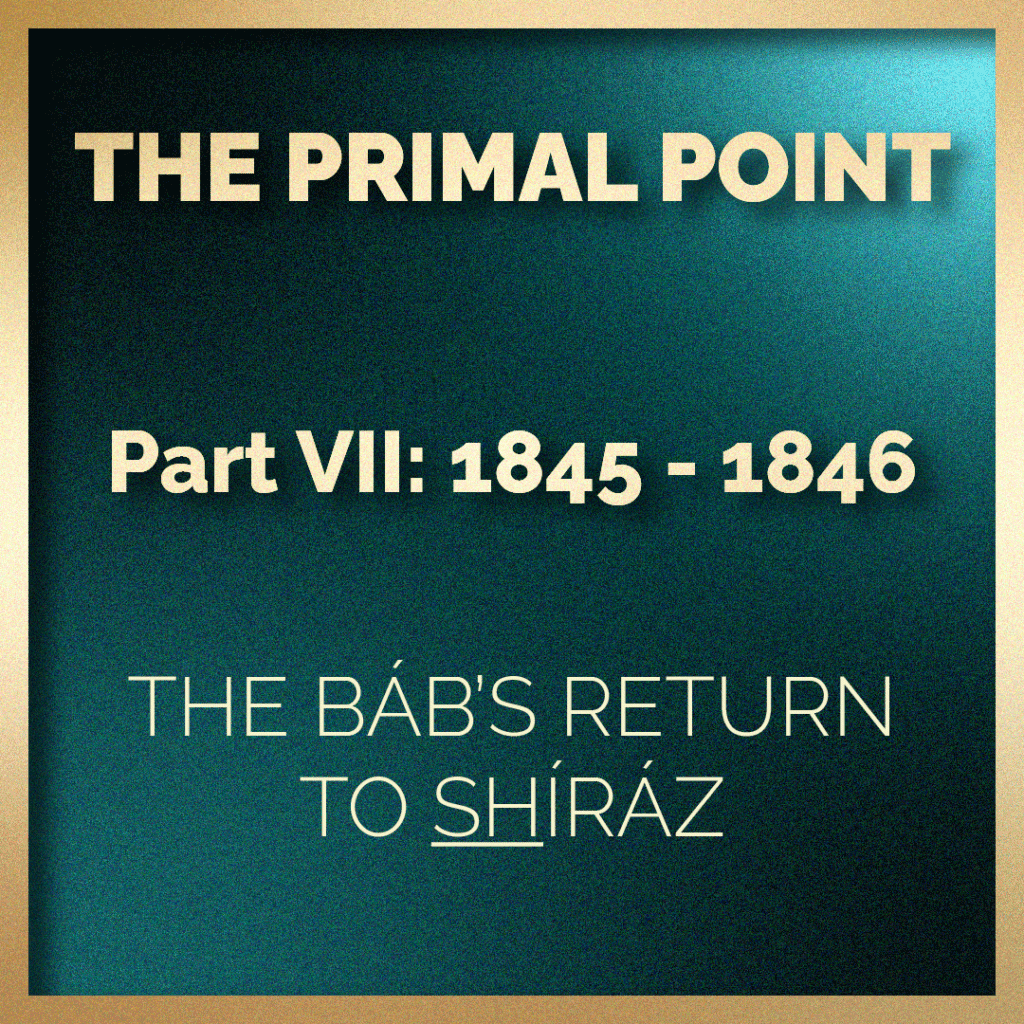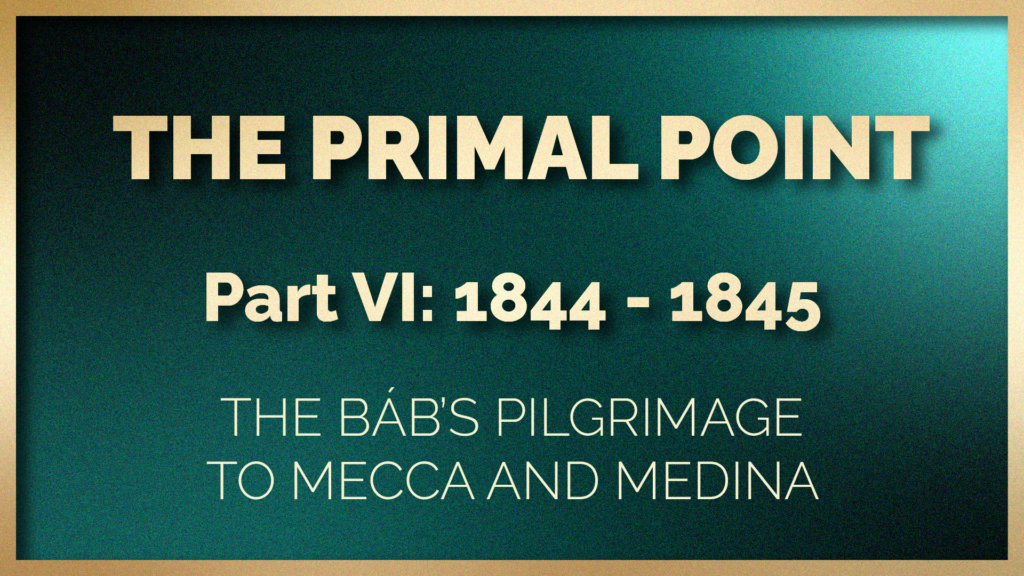
Written and illustrated by Violetta Zein
This part covers the life of the Báb from the age of 25 in 1844 to the age of 26 in 1845.
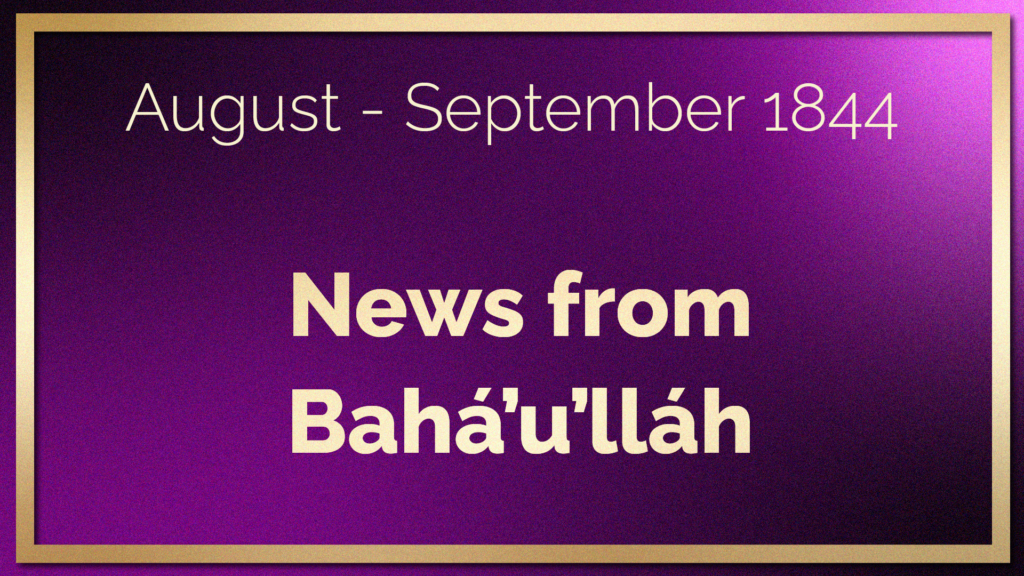
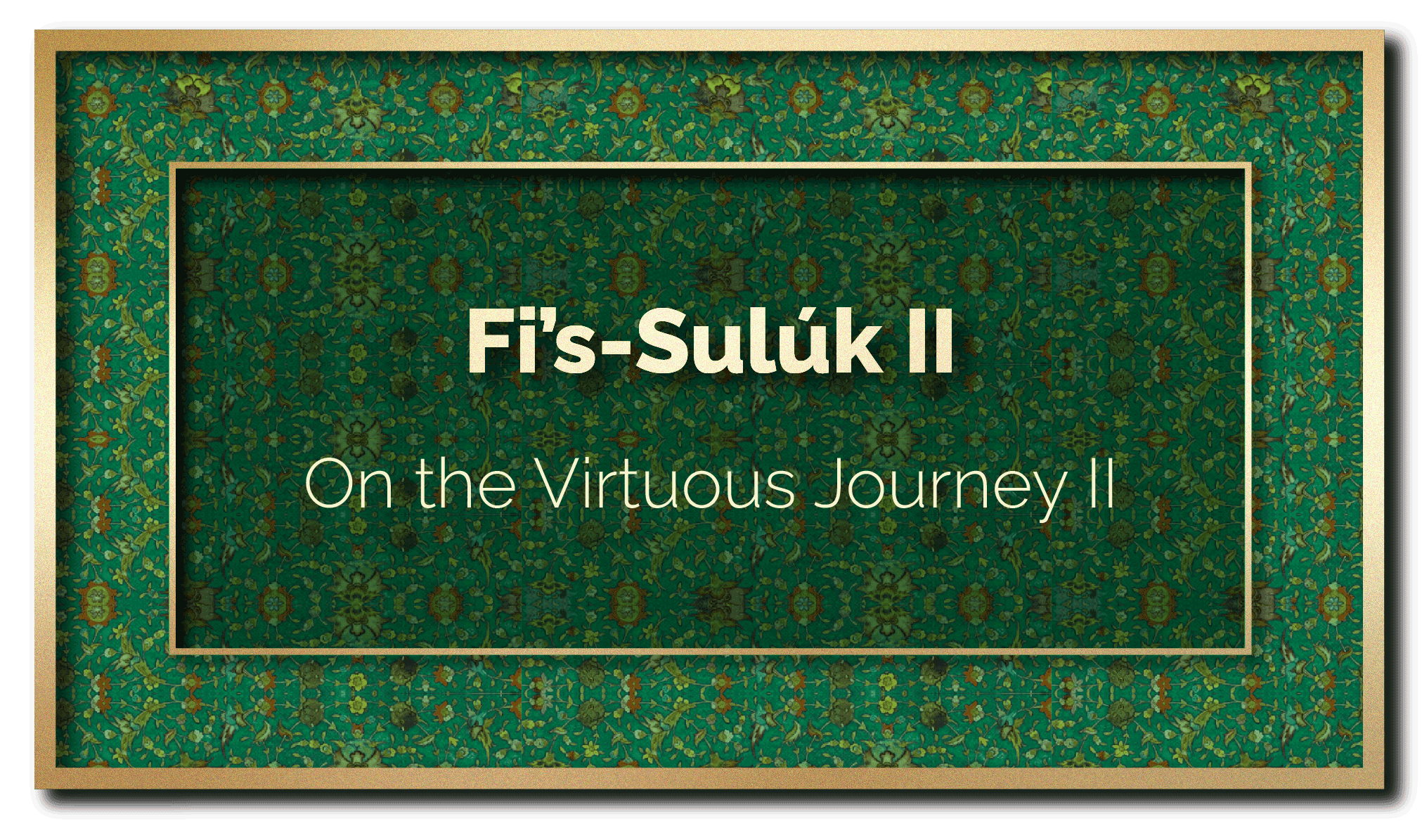
Sometime after His Declaration, the Báb revealed Fi’s-Sulúk II (On the Virtuous Journey II) in honor of Abú Ṭálibi’l-Ḥusaynáví. In this Tablet the Báb develops the idea of a spiritual journey with questions of ethics and moral conduct.
In On the Virtuous Journey II, the Báb expounds on one main principle: the mystic character of action, inseparable from spiritual knowledge and essential in seeking contentment with the Will of God.
The Báb also studies various aspects of contentment and answers Abú Ṭálibi’l-Ḥusaynáví’s question regarding the reward of good deeds on the Day of Resurrection.
It is interesting to note that the word Sulúk has two meanings in Arabic: “mode of conduct” and “spiritual journey”, and Dr. Nader Saiedi states that, at heart, the Fi’s-Sulúk II harmonizes and unites both of the meanings of this word in its content.
At heart, the Fi’s-Sulúk II is a treatise on ethics and laws in accordance to contentment with divine good pleasure. The Báb elevates action as a process of attaining union with God, and speaks about true action being aimed at spiritual truth, while the true spiritual journey itself is absolutely inseparable from action according to divine guidance.
Here is a short excerpt from the Fi’s-Sulúk II on radiant acquiescence with the Will of God:
“Be thou contented, in utter acquiescence and at all times, with the Decree of thy Lord, first in thy soul, and then in thine outward manifestation. Thou wouldst attain the utmost state of contentment with the good pleasure of God when thou art pleased with misery even as thou wouldst be with glory, with poverty as with wealth, with exertion as with tranquility, and with sorrow as with joy, in the states of thy soul and the outward condition that God hath destined for thee.”
Partial Inventory ID: BB00065
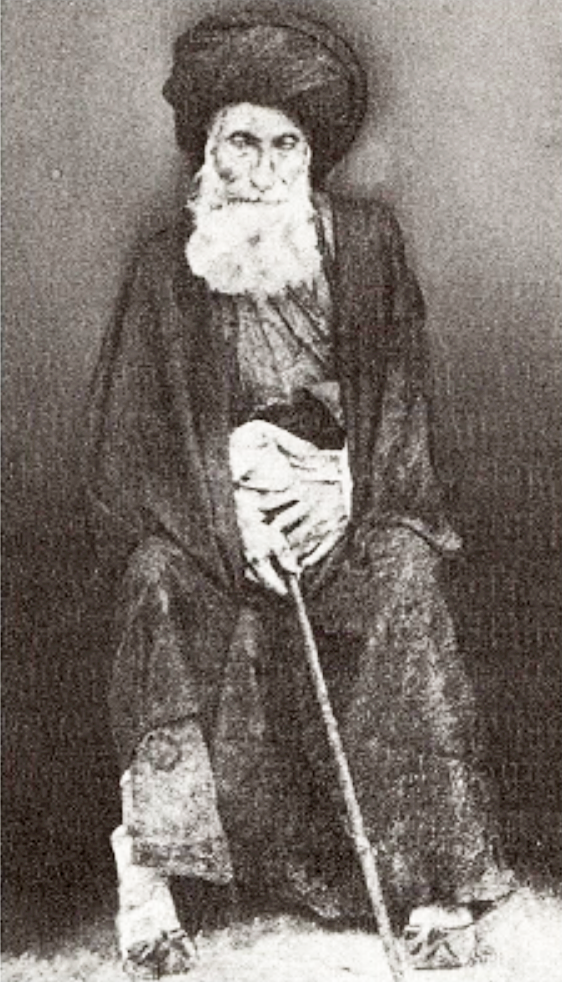
Siyyid Javád-i-Karbilá’í in his old age. Source: Nabil, The Dawn-Breakers, page 189.
When Mullá ‘Alíy-i-Bastamí, the Fourth Letter of the Living, had brought the message of the Báb to Karbilá, Siyyid Javád-i-Karbilá’í, a faithful disciple of Siyyid Káẓim, left for Shíráz. He had known the Báb since His childhood, and had always been impressed with His character, but this time, he returned as a devoted follower.
When he arrived in Shíráz, he was accompanied by Shaykh Ḥasan-i-Zunúzí, the Báb’s amanuensis, but upon arrival, he was too ill to meet the Báb. He received a message from the Báb one night, informing him that He would come in Person to visit him two hours after sunset and instructed him to turn off all lamps before He arrived.
That night, Ḥájí Mubárak accompanied the Báb, carrying a lantern and walking ahead of His Master, in order to divert attention from the Báb. The Báb had told Ḥájí Mubárak to extinguish the lantern as they arrived to where Siyyid Javád-i-Karbilá’í was staying.
When the Báb entered Siyyid Javád-i-Karbilá’í’s dark room, He went straight to his bedside. Siyyid Javád-i-Karbilá’í was holding the hem of the Báb’s robe in the dark, and implored Him:
“Fulfil my desire, O Beloved of my heart, and allow me to sacrifice myself for Thee; for no one else except Thee is able to confer upon me this favour.”
The Báb replied:
“O Shaykh! I too yearn to immolate Myself upon the altar of sacrifice. It behoves us both to cling to the garment of the Best-Beloved and to seek from Him the joy and glory of martyrdom in His path. Rest assured I will, in your behalf, supplicate the Almighty to enable you to attain His presence. Remember Me on that Day, a Day such as the world has never seen before.”
Before taking His leave, the Báb offered Siyyid Javád-i-Karbilá’í a gift to use for himself, and insisted when Siyyid Javád-i-Karbilá’í tried to refuse. Finally, he accepted the gift and the Báb left his room.
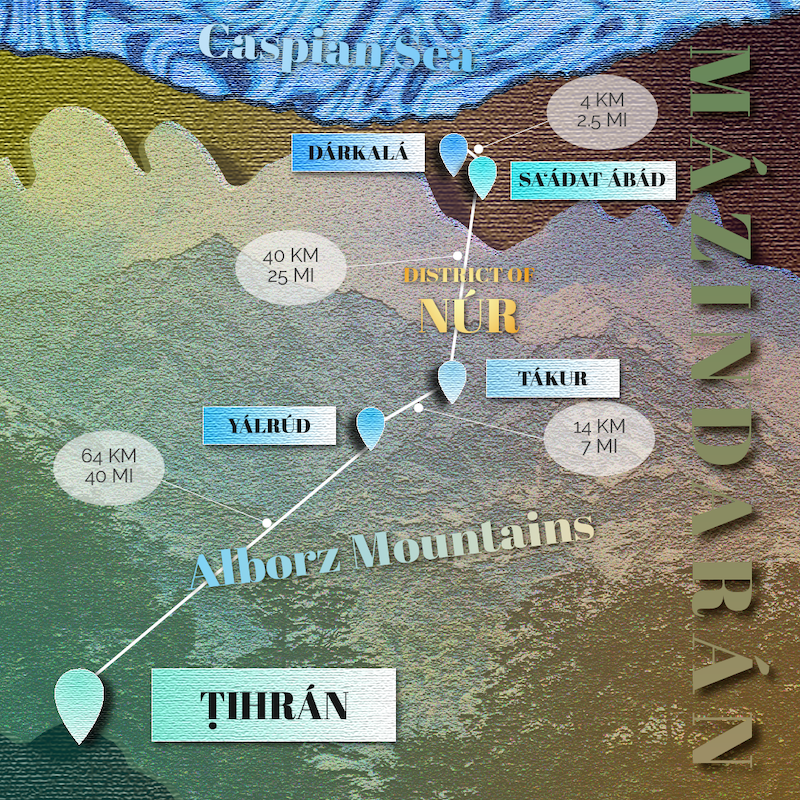
Map of the villages Bahá'u'lláh visited in His home district of Núr when He traveled to proclaim the message of the Báb, immediately after His conversion. This map was drawn from the exact map included by Hand of the Cause Ḥasan Balyuzi in Bahá'u'lláh: The King of Glory, page 38. © Violetta Zein. Source: The Blessed Beauty chronology: Part 1: The early life of Bahá'u'lláh
Mullá Ḥusayn completed the mission the Báb had entrusted to him with great success. He had miraculously found Bahá'u'lláh in Ṭihrán with no information on how to do this, and had delivered, through a mutual acquaintance, the Báb’s Tablet to Bahá'u'lláh. In return, Bahá'u'lláh had conveyed through that same acquaintance, a return gift for the Báb: a loaf of Russian sugar, a package of tea, and the expression of His appreciation and love.
Mullá Ḥusayn had then left Ṭihrán for Khurásán and arrived in Mashhád, where he set about following the rest of the Báb’s instructions. He wrote the Báb his first letter, including a complete report of everything that had happened and the result of his teaching activities.
In the letter he sent the Báb, Mullá Ḥusayn included a detailed report on Bahá'u'lláh’s hugely successful teaching journey in His home district of Núr, which He had spontaneously undertaken immediately after embracing the Báb’s Faith, and enclosed a list of all those who had enrolled in the Faith and sent it to the Báb, again following His instructions and sending the letter first to Tabas, in Khurásán, where it was forwarded to Yazd, and then dispatched to the Báb in Shíráz.
When the Báb received the letter, it caused Him indescribable gladness. Quddús was the only one present with Him when He opened it, and the Báb shared several passages of the letter with His companion. After receiving such glad tidings, the Báb was often heard, joyfully repeating how marvelous were the events that had transpired during that first summer of His Declaration.
In particular, the events that so gladdened the Báb were Bahá'u'lláh’s immediate response to His Divine Message, His bold and immediate teaching endeavours in Núr, and the immense success that rewarded His efforts. These cheered the Báb and reinforced His confidence in the ultimate victory of His Cause, because even if He was felled in His tracks, the master-hand of Bahá'u'lláh would be there to safeguard the Faith. From the moment He received this letter, the Báb was filled with hope and welcomed adversity, divinely confident in the success of His mission.
As soon as the Báb had received Mullá Ḥusayn’s letter, He began to make preparations for His pilgrimage to Mecca and Medina.
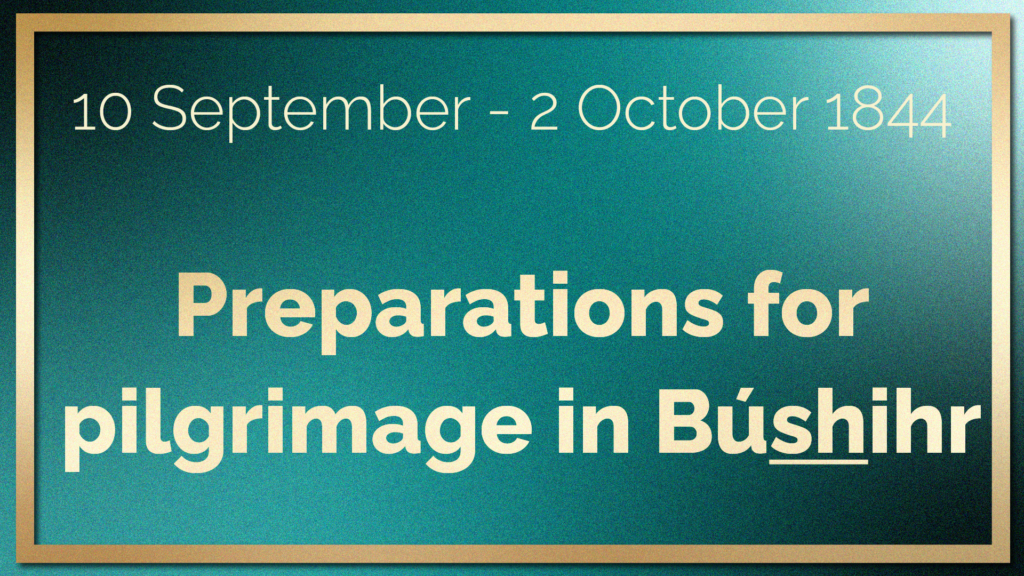
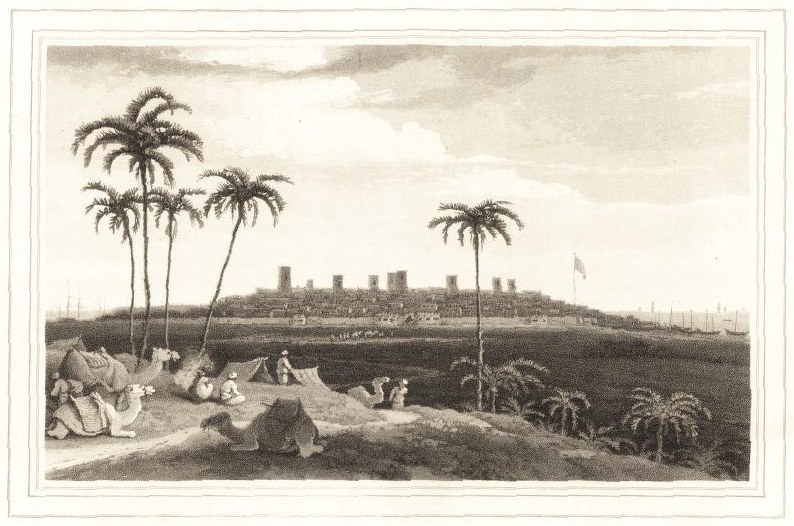
View of Búshihr from "A journey through Persia, Armenia, and Asia Minor, to Constantinople, in the years 1808 and 1809 : in which is included, some account of the proceedings of His Majesty's mission, under Sir Harford Jones, Bart. K. C. to the court of the King of Persia" by James Justinian Morier. Source: Wikimedia Commons.
Before leaving, the Báb left Khadíjih Bagum to Fáṭimih Bagum under the care and protection of His uncle, Ḥájí Mírzá Siyyid ‘Alí.
The Báb left on 10 September 1844, accompanied by Quddús, the Eighteenth Letter of the Living but first in rank, and His loyal and trustworthy Ḥájí Mubárak, and together, they joined the company of other pilgrims from the province of Fárs and left for Búshihr, where they would await for a ship leaving for Saudi Arabia.
This absence of several months was the first time the Báb and Khadíjih Bagum had been separated since their wedding.
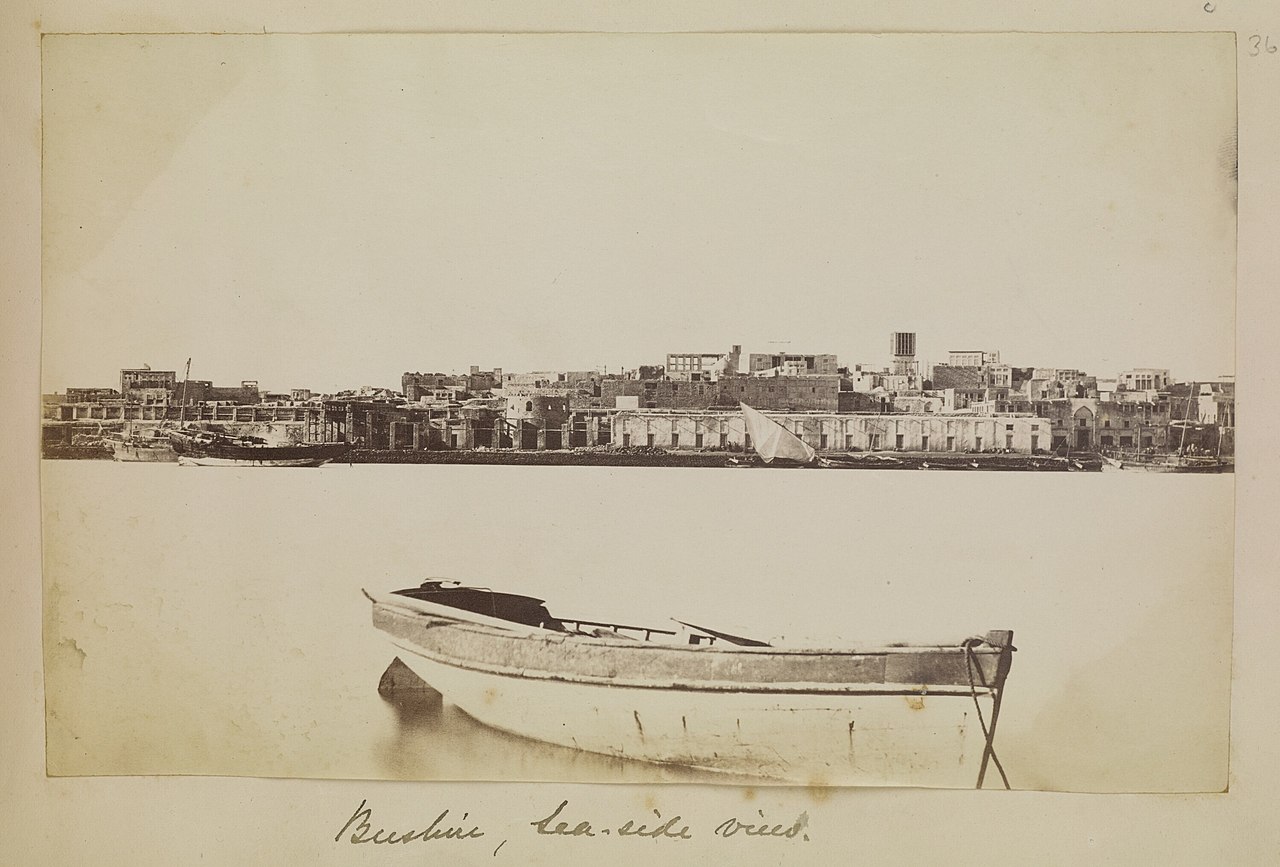
General view of the sea-front at Búshihr. A dhow with a lateen sail can be seen immediately to the right of the center along the horizon. The highest structure along the horizon is a wind tower, which can be seen right of center. In the foreground is a boat at anchor. Taken by an unknown photographer around 1870. Source: Wikimedia Commons.
When the Báb arrived in Búshihr, He wrote to Khadíjih Bagum and informed her that “the weather is exceedingly hot, but God, the Lord of the world, is the Protector,” and informed her the boat would be sailing soon, praying, in His letter that “God, the Lord of the world, will provide protection by His grace.”
The Báb had not been able to say goodbye to His mother before leaving Shíráz and so He asked Khadíjih Bagum to give Mother His salutations and request her prayers, then mentions He was planning to write to Bombay, India in order to purchase some goods, before ending the letter with:
“God willing, that which is decreed will come to pass. Peace be upon thee and the mercy of God and His blessings.”
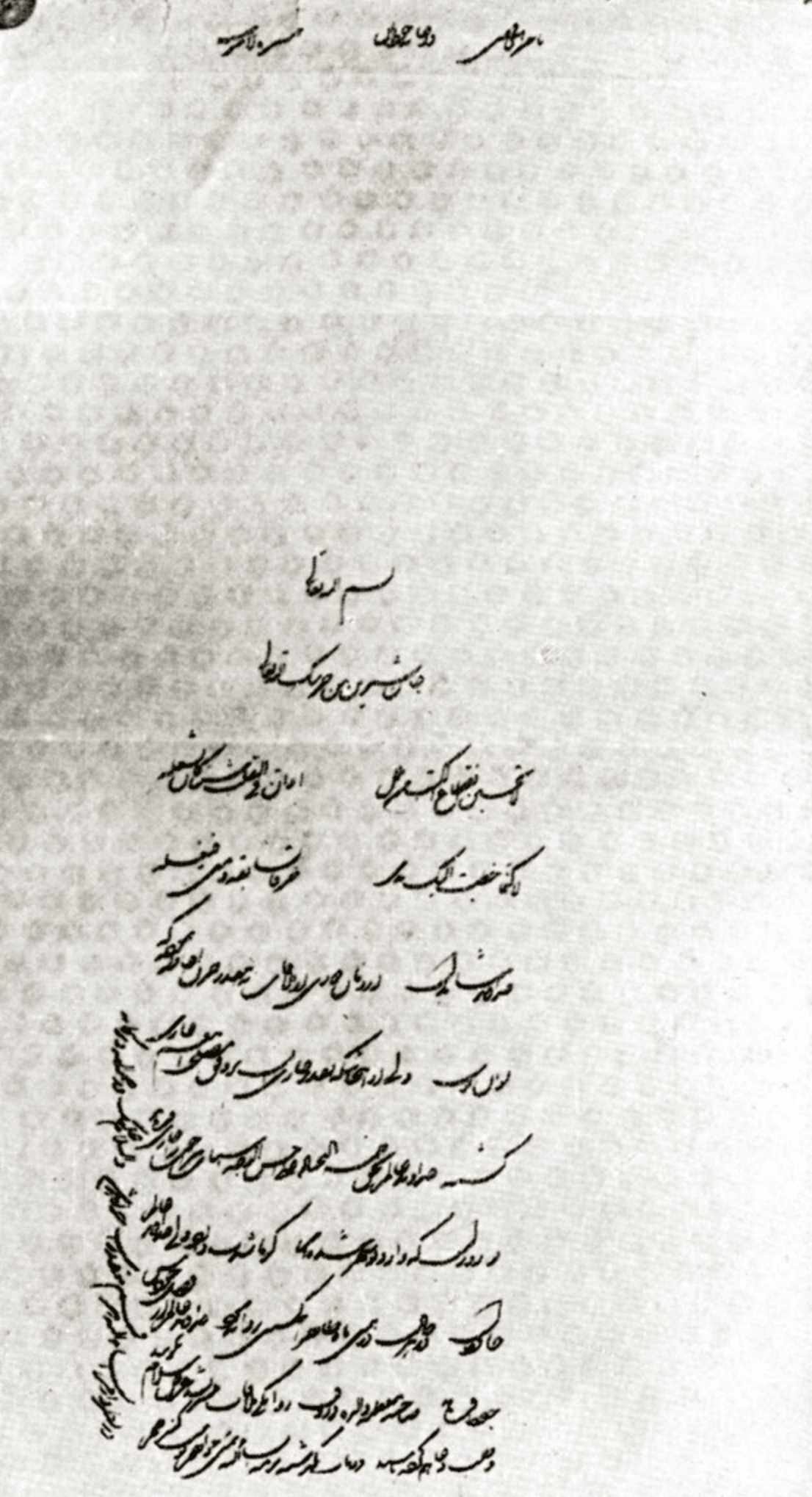
Original manuscript in the hand of the Báb of the second letter He sent to Khadíjih Bagum from Búshihr, an excerpt of which is in the story below. This manuscript is Partial Inventory ID: BB00541, and a typescript of the original letter prepared by the Bahá'í World Centre is provided by the Afnán Library Online. Many thanks to Adib Masumian for providing the information for this precious letter. Source: Bahá'í Sacred Relics.
Two days after arriving in Búshihr, 21 September 1844, the Báb wrote a second letter to His wife, which begins with the words “In the Name of God, exalted is He. My sweet love, may God preserve thee” and continues:
“God is my witness that since the time of our separation, such griefs encircled me as are beyond description. But since destiny is so all-powerful, it is due to a fitting purpose that this [separation] occurred in this way. May God, in the name of Five Holy Souls [Note: According to the Ḥadíth Al-Qisa, The Five Holy Souls are the Prophet Muḥammad gathering Fáṭimih, ‘Alí Ḥasan and Ḥusayn under His cloak] provide the means of my return as may be best. It is two days since I entered Búshihr. The weather is intensely hot, but God will protect [me]. At any rate, it appears that in the very month the ship will sail. Gracious God shall protect us.”
The Báb stayed in Búshihr for two weeks before sailing to Jaddih, making arrangements for His pilgrimage and waiting for Mullá Ḥusayn’s letter.
Partial Inventory ID: BB00541

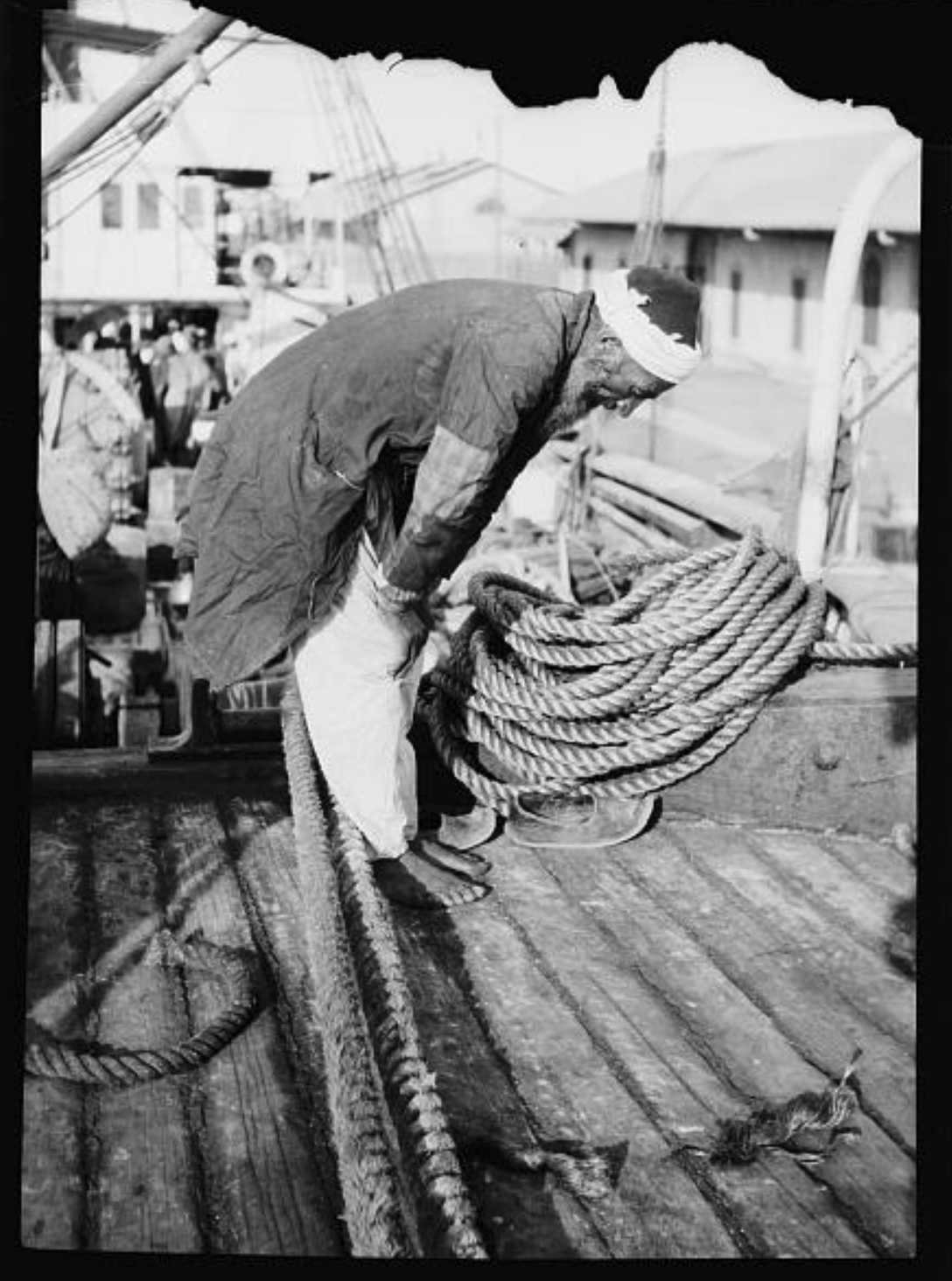
Pilgrim to Mecca praying on a sailboat to Saudi Arabia. Source: Library of Congress.
On 2 October 1844, the Báb boarded a very aptly named Arab sailing boat: Futúḥ-ar-Rasúl (“Victories of the Messenger”) with Quddús and Ḥájí Mubárak. Traveling with the Báb bound for pilgrimage were at least four people the Báb knew.
First, Muḥammad-Báqir Khán, a maternal uncle of Muḥammad Sháh and his attendant, Shukru'lláh Khán-i-Núrí an official of the province of Fárs.
There were also two fellow Shírázís aboard. The first was a merchant, Ḥájí Abu'l-Ḥasan, who embraced the Faith of the Báb, and the second, Shaykh Abú-Háshim, was the brother of the leader of Friday Prayers in Shíráz. This man started out at the outset jealous of the Báb, and would become an inveterate enemy.
Shaykh Abú-Háshim became increasingly arrogant and argumentative as the journey went on, picking fights with the other passengers, and targeting the Báb with insults. The Arab captain of the Futúḥ-ar-Rasúl got to a point where he could no longer stand the Shaykh and ordered him thrown into the sea.
The Báb pleaded for his life, and when He saw the sailors were about to cast Shaykh Abú-Háshim overboard, the Báb threw himself on the unpleasant man and requested that the captain pardon him. The Arab captain was astonished at this turn of events because the Báb had been the victim of most of the Shaykh’s abuse, but the Báb made a fascinating reply.
He argued that since people who behaved in the way the Shaykh had done only really hurt themselves, the rest of us should be tolerant and forgiving towards them.
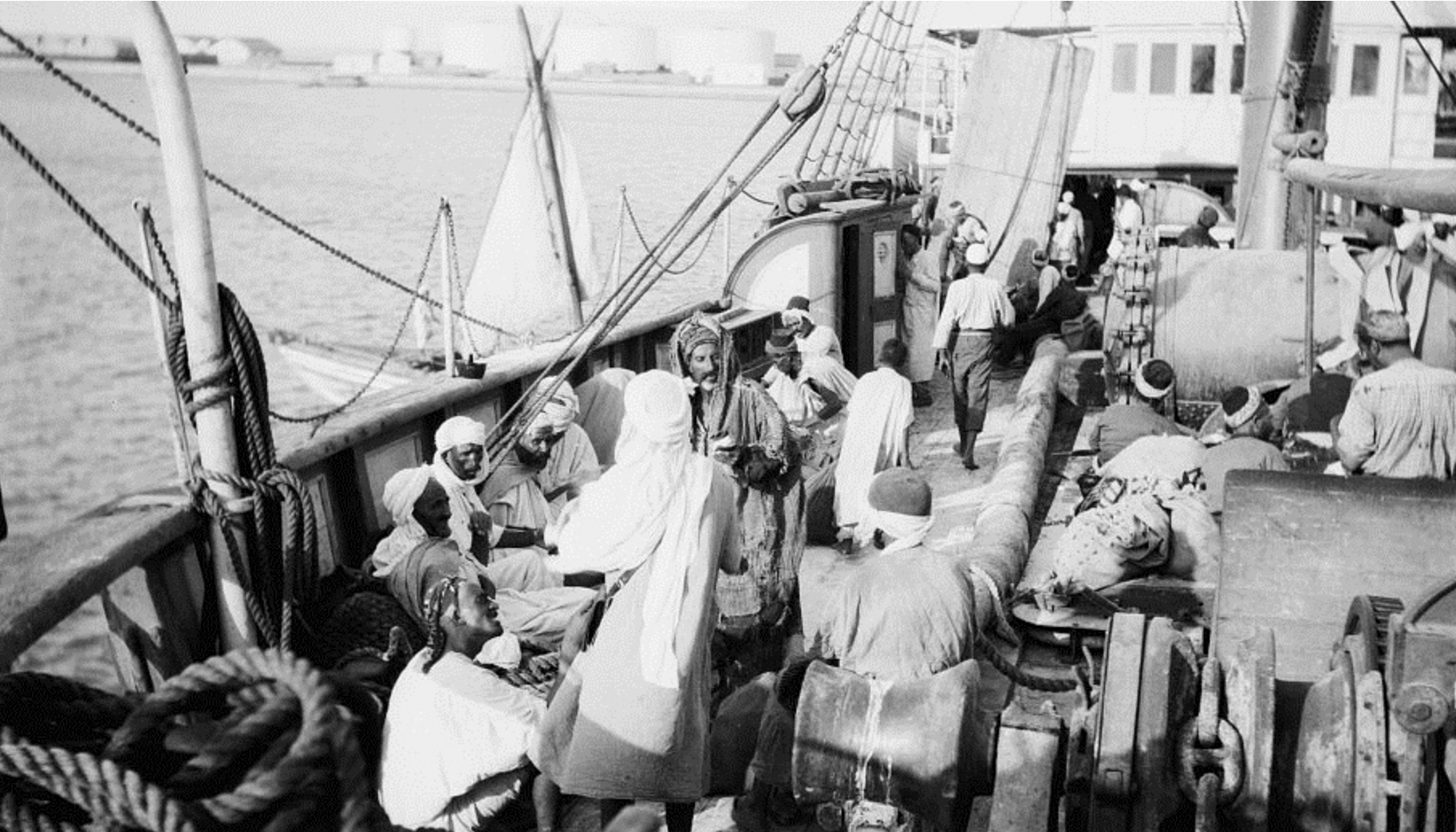
Between 1900 – 1920. To Sinai via the Red Sea, Tor, and Wady Hebran. Mecca pilgrims on deck a ship. Source: G. Eric and Edith Matson Photograph Collection, Library of Congress.
The sea journey took two months of slow, stormy, and unsteady sailing. Despite these conditions and the complete lack of comfort, nothing could interfere with the Báb’s regular and peaceful prayers and meditations.
Oblivious of the storms raging around Him, the lack of drinking water, the sea-sickness and panic of the other pilgrims, the Báb was continuously absorbed in revealing prayers and Tablets, and dictating them to Quddús, both of them serene amidst the chaos.
At one point during the journey, the scarcity of water on board the ship was severe, and the Báb stated:
“For days we suffered from the scarcity of water. I had to content myself with the juice of sweet lemon.”
During this journey, the Báb was carefully preparing Quddús for his great destiny, which would unfold far away from the Báb.
The Báb was the epitome of cleanliness and courtesy, and He would often counsel:
“Never sadden anyone, no matter whom, for no matter what.”
The two-month sea journey confronted Him with the selfishness of the pilgrims, exacerbated by the exceedingly difficult and unclean travel conditions.
One incident which stayed with the Báb was the sight of a very wealthy notable on the boat who was spending large amounts of money but would not splurge pennies for a glass of water for a fellow-traveler.
In the Bayán, the Báb would later reveal:
“The saddest thing that I saw on my pilgrimage to Mecca was the constant disputes of the pilgrims between themselves, disputes which took away the moral benefit of the pilgrimage.”
Though the Báb uttered no complaint during the journey, He kept a very unpleasant memory of the journey, and, a mere few weeks later, in His Epistle Between Two Shrines (see below), He would in no uncertain terms, state:
“Know that the sea voyages are hard. We do not favor them for the faithful; travel by land.”
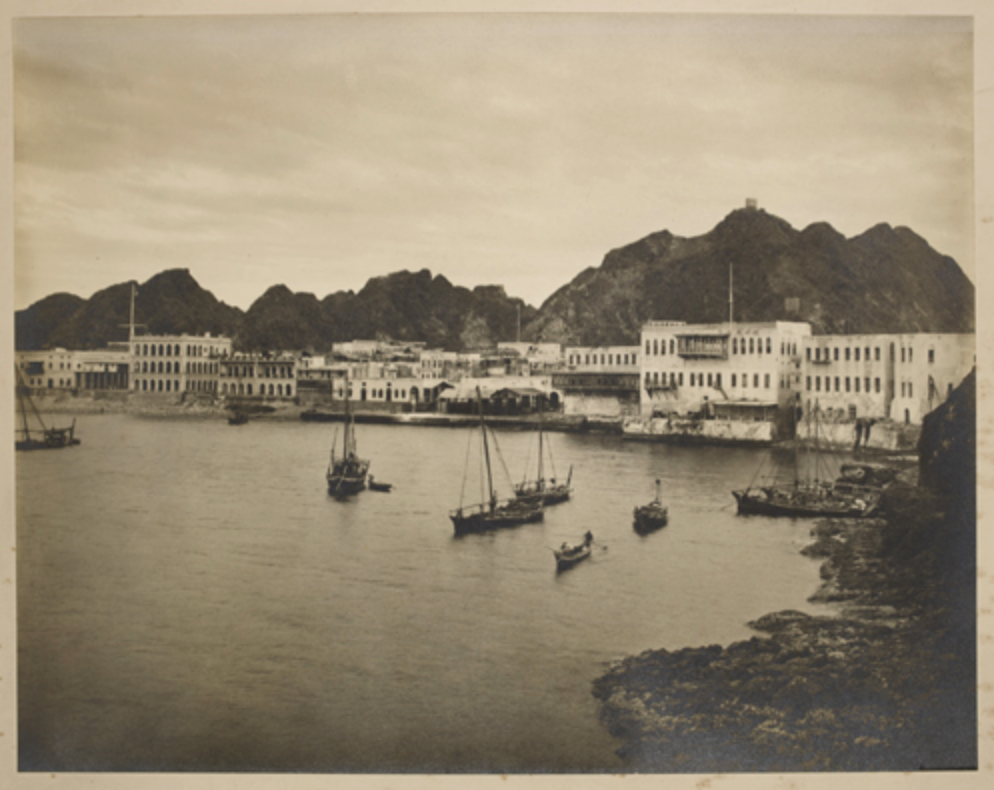
View of the waterfront at Muscat, 1900s. Source: British Library Images Online.
The journey in the Persian Gulf from Búshihr to Musqat, Oman lasted 12 days.
The Báb arrived in Musqat on 14 October 1844, and anchored for several days, during which He attempted to convert people to the Bábí Faith, without success.
The Báb Himself bears witness to the difficulties He encountered both teaching in Musqat, and teaching on the boat, in an excerpt translated by A.L.M. Nicolas which reads in part:
“Say: We have not seen in Musqat men of the Book willing to help him [a person the Báb taught] because they are lost in ignorance. And the same was true of all these voyagers on the boat with the exception of one who believed in our verses and became one of those who fear God.”
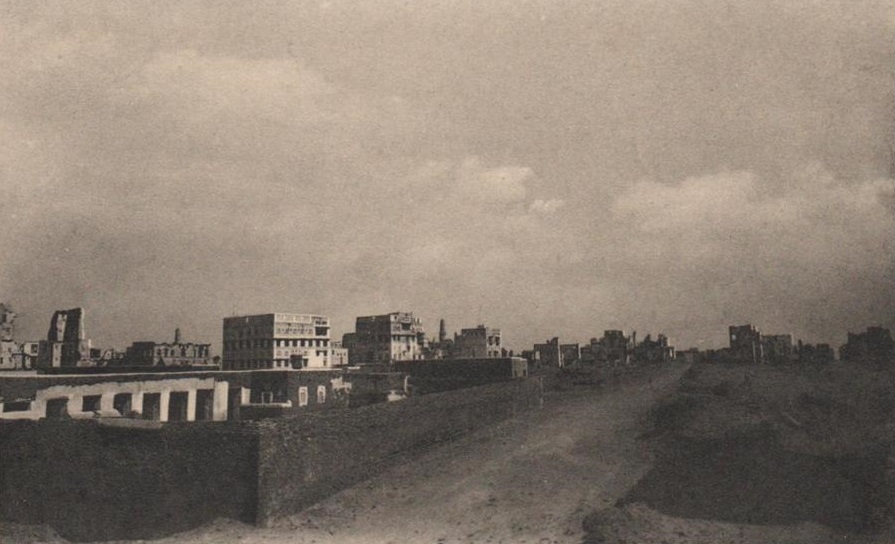
General view of Mukhá, Yemen in the early 20th century, from land. Source: Wikimedia Commons.
While in Mukhá, Yemen, a port on the way to Jeddah. the Báb wrote a long and deeply touching letter to His mother, where He sends His love to His wife, asks Fáṭimih Bagum to kiss the eyes of the children of the family, and mentions Ḥájí Mubárak.
It is incredibly touching to notice that the Báb mentions previous letters written to His mother from Búshihr, and from Musqat, Oman, another port where the boat must have anchored, as well as a letter to Khadíjih Bagum also sent from Mukhá, indicating He was in constant communication with both His mother and His wife during His pilgrimage.
The letter, dated 21 November 1844, halfway through the Báb’s sea voyage, reads, in part:
“This is a letter written from the port of Mukhá to the honourable mother, may God, the Most Exalted, keep her safe! She is most certainly eager to know about the well-being of her son. A letter was sent from Búshihr. I trust God, the Most High, that it hath been illumined with the honour of thy perusal. I explained in the letter sent from Búshihr the details up to Musqat. Surely, it hath been conveyed to thy noble presence. Praised be God, my health until this day that I arrived in Mukhá hath been good and there hath been no change in my condition. With assistance from God, exalted be He, soon I shall reach the spot where prayers are answered. I will most certainly pray on thy behalf and on behalf of honourable grandmother. Through God’s bounty, no ground for doubt exists and refusal cannot be imagined. Mubárak continues to find life in service. He does what he needs to do with the help of the accompanying religious students. Convey greetings to everyone.”
At the time, the prevailing custom dictated that it was improper to write a woman’s name directly on the envelope of a letter, so the Báb’s letters to His wife and mother were addressed to Ḥájí Mírzá Siyyid Muḥammad, Fáṭimih Bagum’s brother living in Búshihr, who would then forward it to his sister in Shíráz.
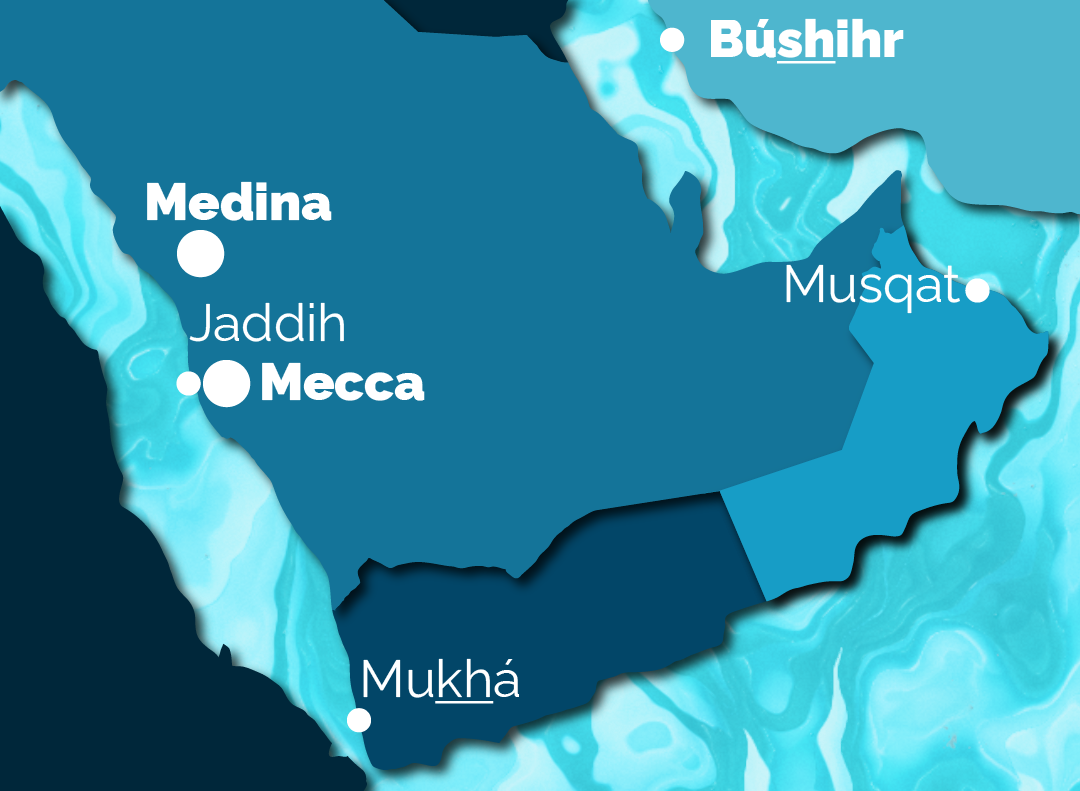
Map of the Báb’s pilgrimage showing only two of His many stops during the two-month sail from Búshihr, Persia, to Jaddih, Saudi Arabia. Mecca and Medina, to two locations of His pilgrimage are larger than the stops. © Violetta Zein
The Báb’s family was very closely knit. From the letters they exchanged, it is clear they were open with each other, caring, and honest.
When Ḥájí Mírzá Siyyid Muḥammad received the letters the Báb had written from Mukhá, he forwarded the one to Khadíjih Bagum and only later noticed there was a second one, addressed separately to Fáṭimih Bagum. He forwarded this letter later, and it arrived after the Báb had returned, but the cover letter he included is deeply significant.
After apologizing profusely for his mistake and explaining in detail how it happened and which steps he had taken to correct it, Ḥájí Mírzá Siyyid Muḥammad demonstrates his deep understanding of the Báb’s station and His claim. He prepares Fáṭimih Bagum and her mother for the inevitable repercussions that would soon come, and his wife, keenly insightful, asked her husband to convey a simple and straightforward message to Fáṭimih, showing how the women of the family of the Báb related to one another:
“You must have perused all of them [the letters] and felt elated that in truth His Self, the source of munificence, is the light of the eye of this world and the next. He is our pride. Praised be God, praised be God! It is hoped that you have certainty in His Cause and that you have not allowed doubt to enter your heart because of people’s idle talk. Let not any tale cause you fear or produce vain imagining. The Creator of the universe is His Protector and Helper. I have nothing further to say. I am myself very eager to be of service and beseech prayers. Peace be upon you, and mercy of God and His blessings. The loved ones all wish you peace and say may your eyes be illumined! The mother [his wife] of the ones who are the solace of the eye [the children] sends her regards and says to my sister: ‘I wish I were there.’ Say to the mother of Áqá Mírzá Abu’l-Qásim [Khadíjih Bagum’s mother, the mother-in-law of the Báb], ‘Praised be God, I have nothing to be ashamed of. You have a son-in-law who is peerless in the world. The inhabitants of the globe should all obey Him.’”
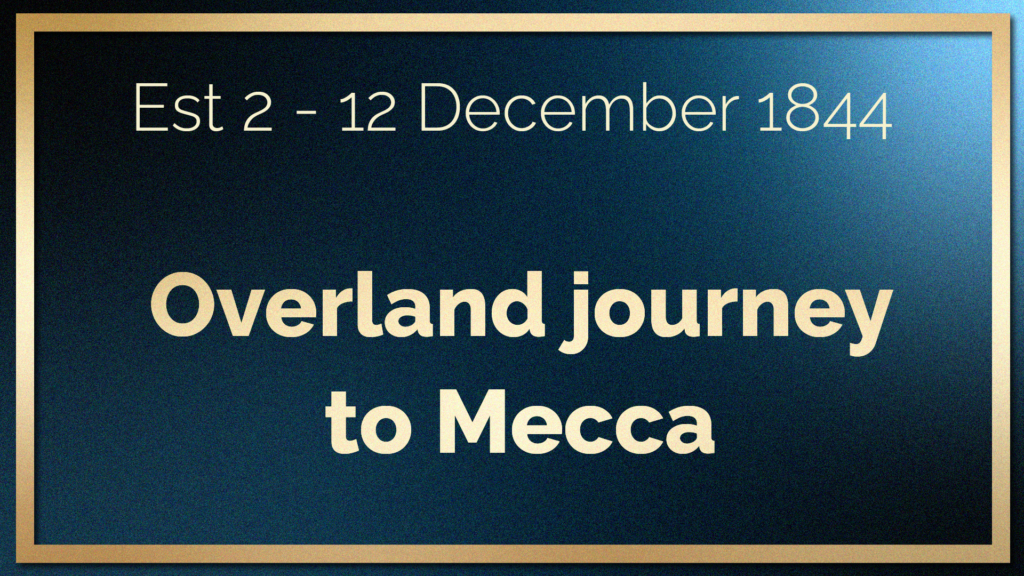
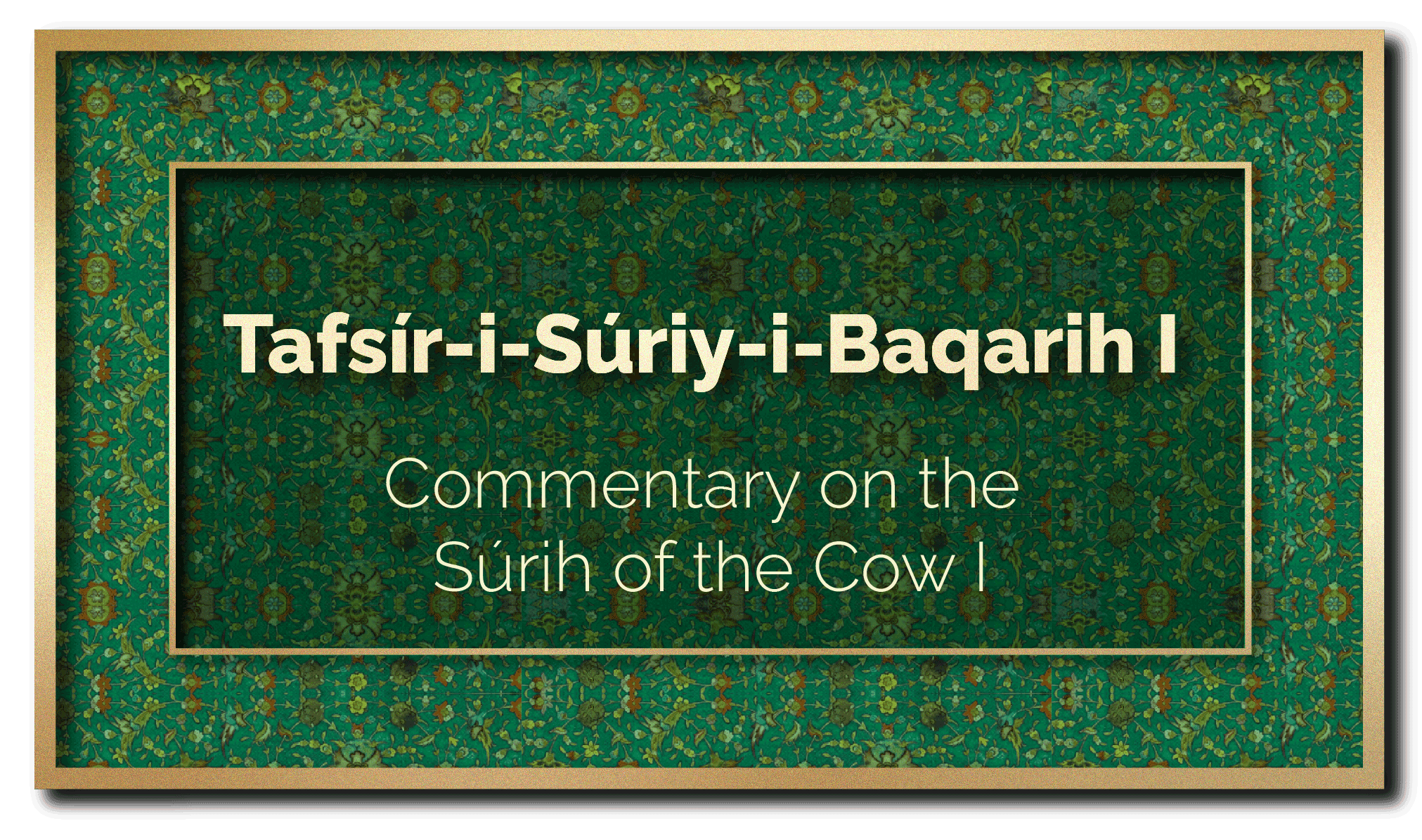
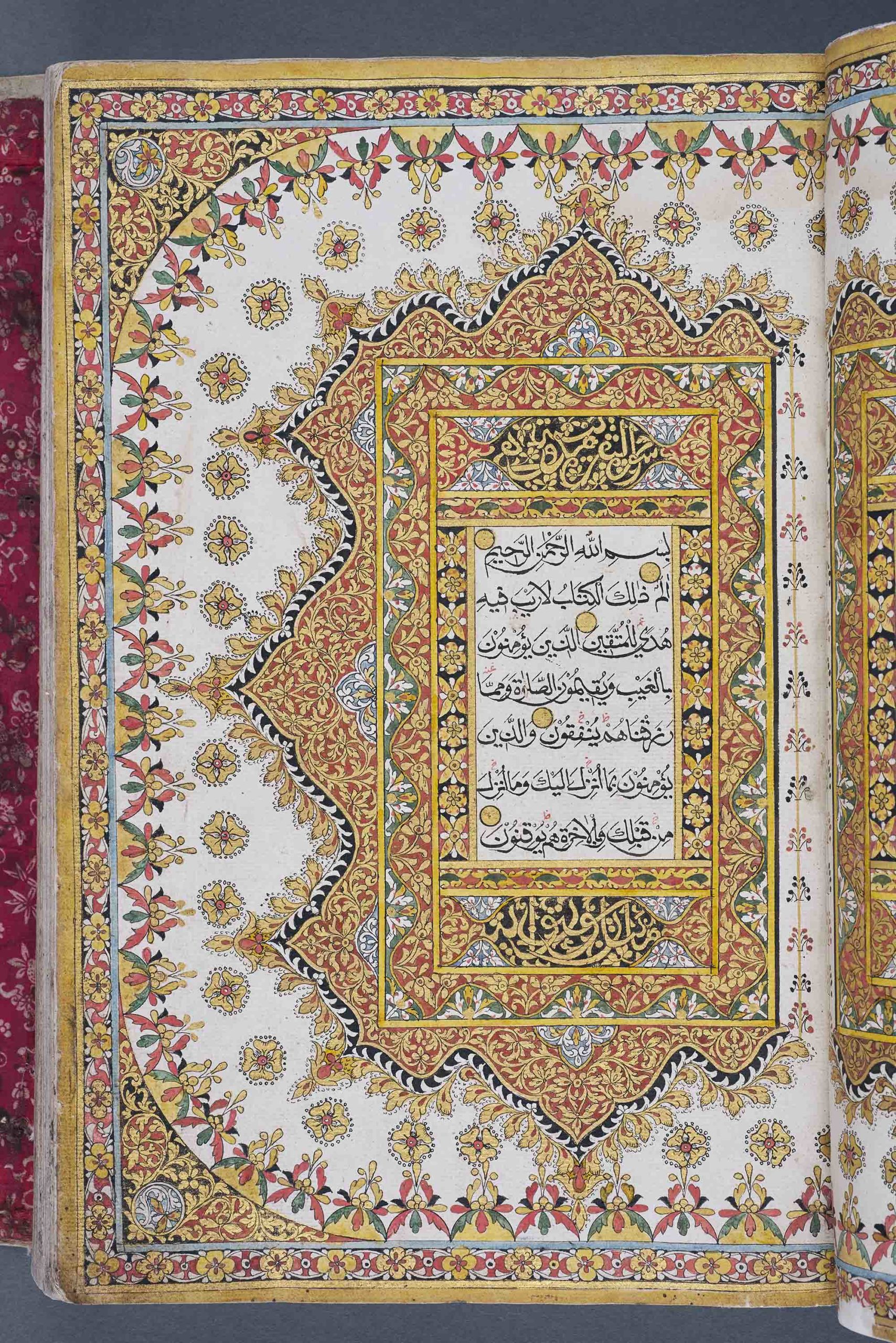
Left-side of a double-page opening of the Qur’án from Terengganu with beginning of the chapter Al-Baqara (the Súrih of the Cow). End of the 18th or 19th century. Asian Civilisations Museum: Source: Wikimedia Commons.
In the space of one year from January 1844 to January 1845, while He was on pilgrimage and finished His commentary, the Báb revealed Tafsír-i-Súriy-i-Baqarih I (Commentary on the Súrih of the Cow I).
The commentary on the Súrih of the Cow I is one of the Báb’s most major books, and is composed of two major parts:
- Part I, a complete text, is the interpretation of the first juzv (a unit meaning one-thirtieth of the Qur’án), running through verse 141 of the Súrih of the Cow. This commentary was begun on the night of Siyyid Káẓim’s passing and was completed at the beginning of 1845, both dates being mentioned by the Báb in the text of the Commentary itself.
- Part II, Tafsír-i-Súriy-i-Baqarih II (Commentary on the Súrih of the Cow II) was a commentary on two verses of the Súrih of the Cow, interpreted in light of the ultimate truth of the Word of God, His Will and His Manifestations. This was one of the works which would be stolen by the Bedouin on the way between Mecca and Medina in the following story.
The Commentary on the Súrih of the Cow I is a continuous interpretation which the Báb did not divide into chapters, as He had with the Qayyúmu'l-Asmá'. The subject is the Súrih of the Cow, the second chapter of the Qur’án and the longest, at 268 verses and over 6,000 words. It contains the single longest verse in the entire Qur’án and begins with the three disconnected letters, Alif, Lám, and Mím (A, L, M), also known as the “mysterious letters.” These mysterious letters open 29 of the 114 Súrihs of the Qur’án and the Báb interprets them in the Commentary on the Súrih of the Cow I:
“For the people of truth, this verse representeth the recognition of God, glorified be He, for they recognize all the Qur’ánic letters as one letter, and all their meanings as a single meaning, regardless of the difference in letters and the diversity of meanings…For verily they behold naught but God
The letter Alif referreth to Muḥammad, the blessings of God rest upon Him, for He representeth the Guardianship of God (Alláh); the letter Lám referreth to ‘Alí, peace be upon Him, while the letter Mím standeth for Fáṭimih, the blessings of God rest upon Her. Verily, God hath created Lám and Mím by His bidding, so that when joined together they signify the word Be (Kun), whereby the heavens and earth were raised up by His Command...”
Partial Inventory ID: BB00008
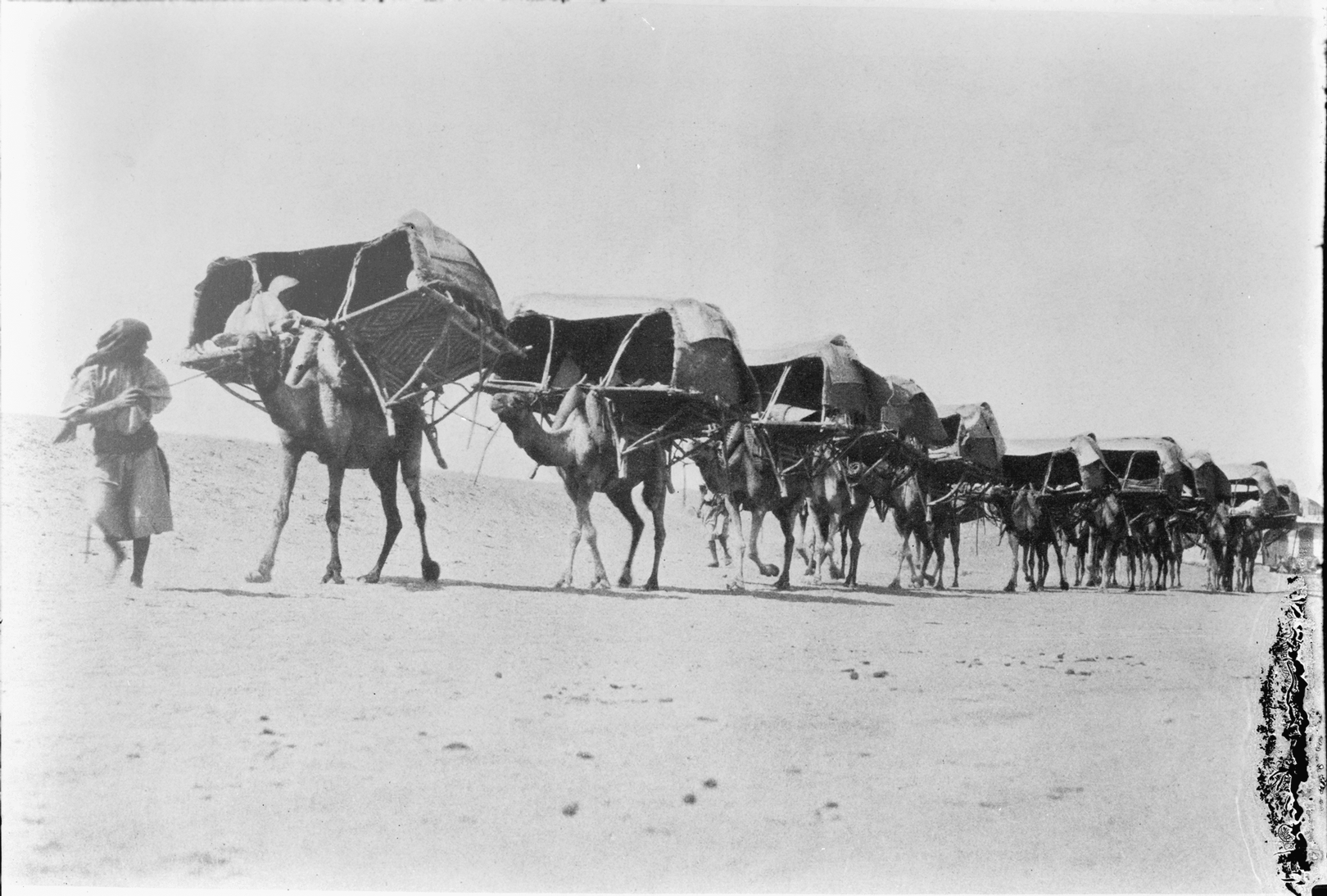
A camel caravan traveling to Mecca for the annual pilgrimage, circa 1910. Source: Wikimedia Commons.
Once the Báb arrived in Jaddih, the Báb and His companions donned the iḥrám, the garb of a pilgrim, mounted a camel, and headed for Mecca. Quddús walked in front of the camel, holding the animal’s bridle, joyfully and prayerfully attending to the needs and safety of the Báb, and indifferent to his own tiredness.
One day at dawn, during their journey, they broke their journey near a well so that the Báb could do His ablutions and offer His morning prayer. Ḥájí Mubárak unpacked the loads from the backs of the camels and prepared to settle down.
Just as the Báb began to pray, a Bedouin appeared as swift as lightning, snatched the saddlebag filled with many of the Báb’s Tablets and ran away with them. Ḥájí Mubárak chased the thief, hoping to catch him and retrieve the Báb’s precious satchel, but the Báb motioned him to stop.
After He had completed His prayers, the Báb showered affection and kindness on Ḥájí Mubárak, explaining that God would reward him, explaining why He had stopped him from giving pursuit, explaining affectionately that God had intended for His Tablets to be disseminated in this mysterious manner:
“Had I allowed you, you would surely have overtaken and punished him. But this was not to be. The papers and writings which that bag contained are destined to reach, through the instrumentality of this Arab, such places as we could never have succeeded in attaining. Grieve not, therefore, at his action, for this was decreed by God, the Ordainer, the Almighty.”
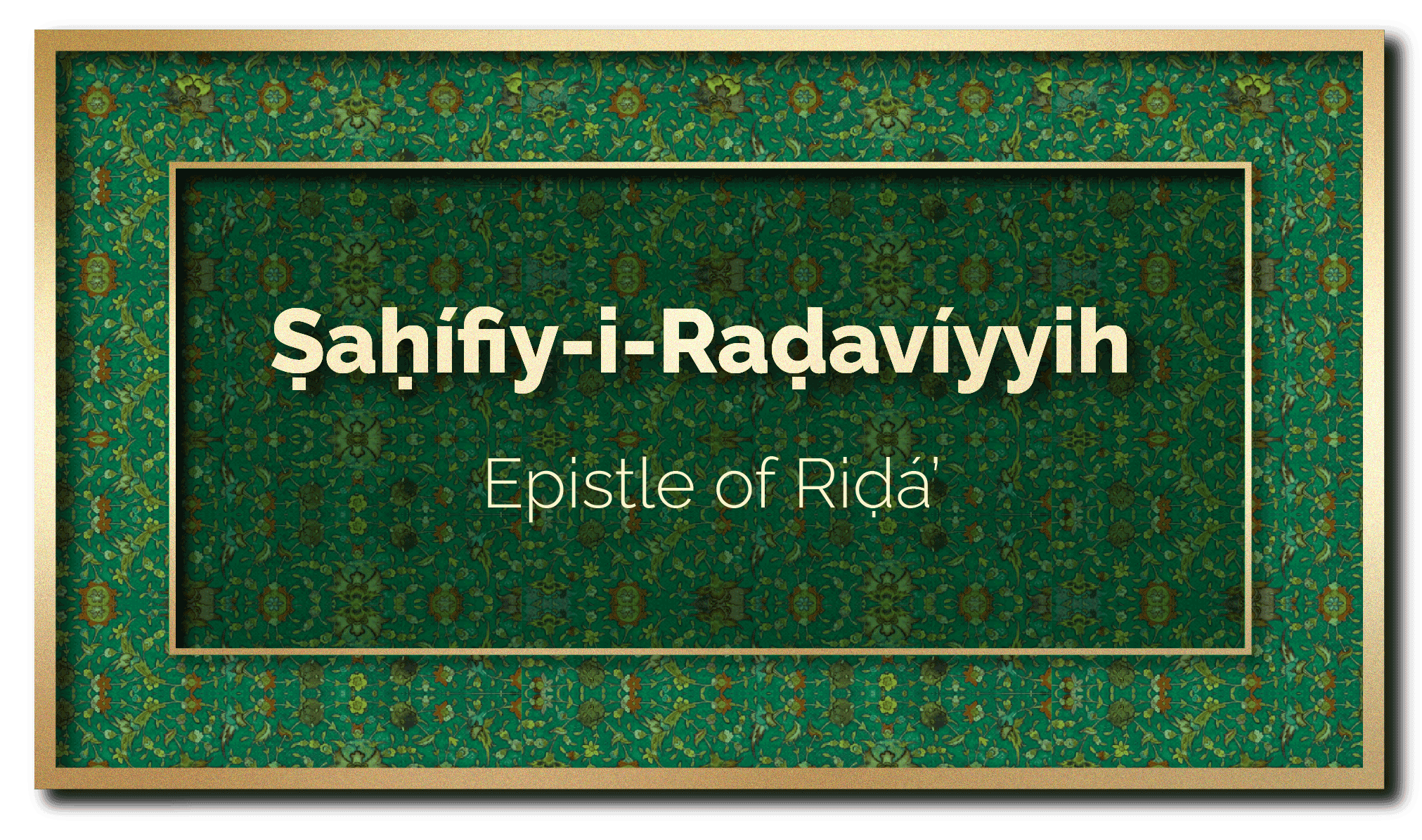
The placement of this work in this place in the chronology is symbolic. We know it was revealed after the Báb’s Writings were stolen by the lone Bedouin, and while He was completing pilgrimage to Mecca and Medina, but we do not have a more exact date.
It is important to note that, although most of the sermons were revealed when the Báb was in Saudi Arabia, the first sermon was composed one year later, and will be addressed, accordingly, in January 1846.
During His pilgrimage to Mecca and Medina, the Báb revealed a long epistle called Ṣaḥífiy-i-Raḍavíyyih (Epistle of Riḍá’), consisting of 14 Sermons, written at different points of His journey.
For a discussion of the first sermon, Khuṭbiy-i-Dhikríyyih (Sermon of Remembrance), see the section in January 1846.
The second sermon, Kitábu’l-Fihrist (The Book of the Index) was revealed some six months later in Búshihr, and it will be addressed at the time of its Revelation, on 21 June 1845.
The Khuṭbiy-i-Dhikríyyih, the first of the 14 sermons, revealed near the end of the first, interpretive stage of the Báb’s Revelation lists 14 of His Writings: 4 books and 10 epistles, identifying this epistle, the Ṣaḥífiy-i-Raḍavíyyih as number 6.
In the 11th sermon, the Khuṭbiy-i-Jiddah (Sermon of Jiddah), the Báb lists the names of the works that the Bedouin stole when He stopped at the well near Jiddah to perform His ablutions, and provides a list of 11 dates for His journey from Búshihr to Mecca, Medina, and Jiddah, and back, dates which were used in this chronology for those events.
The other 12 sermons in the Ṣaḥífiy-i-Raḍavíyyih emphasize the absolute transcendence of God, the significance of the martyrdom of the Imám Ḥusayn, the peerless Station of the Báb, the spiritual significance of the history of the Báb’s life, and various dates during His pilgrimage to Mecca and Medina.
Partial Inventory ID: BB00137 (Contains 14 sermons)
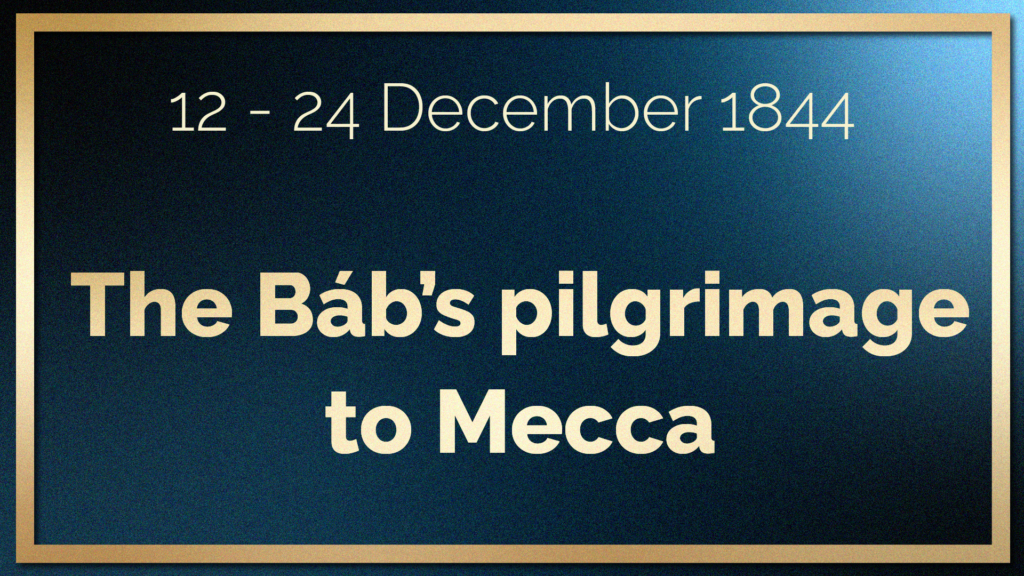
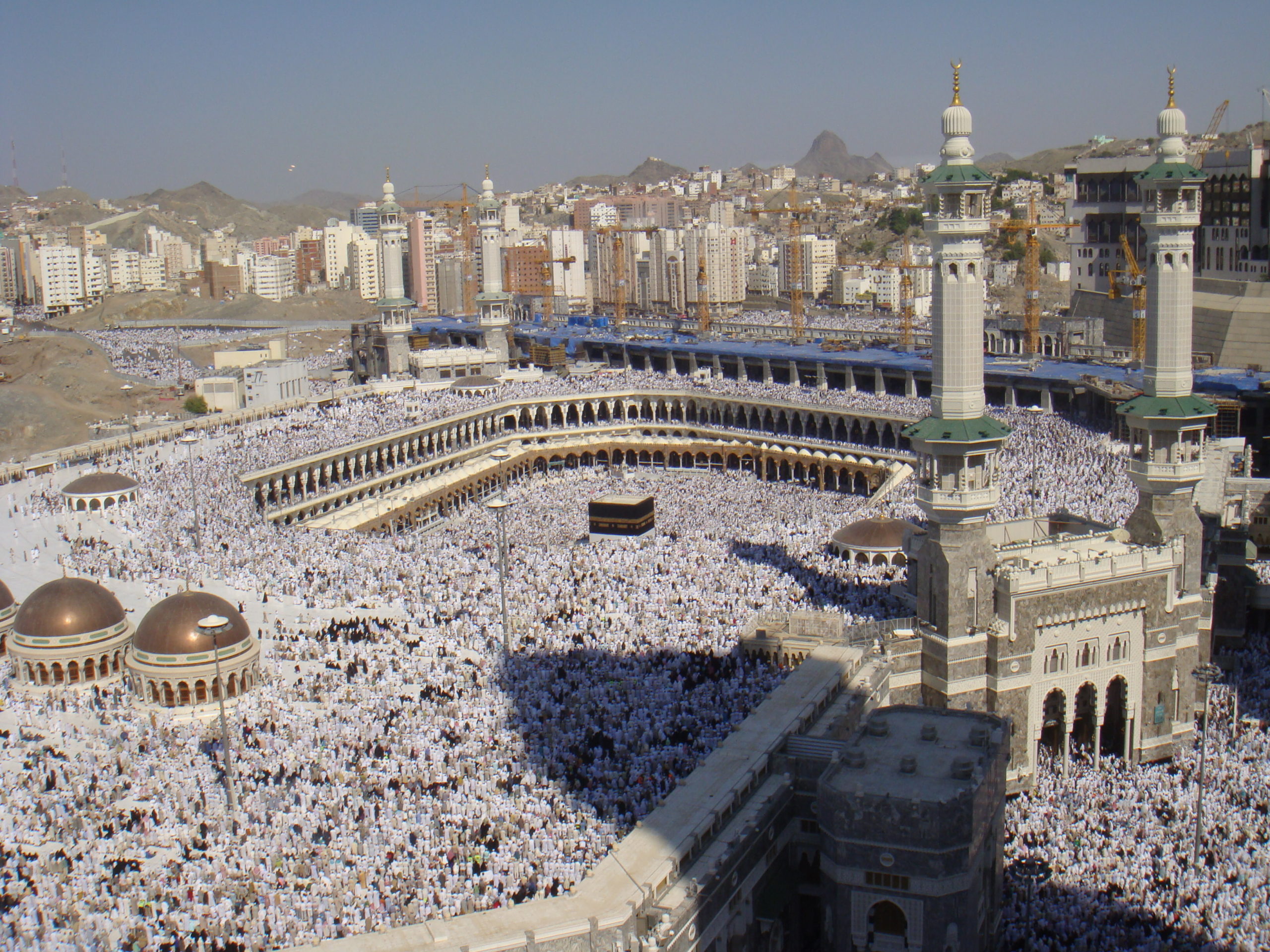
The Masjid al-Haram (The Inviolable Mosque), the largest and one of the two oldest mosques in the entire world, home of the Ka’bih, towards which all Mulsims turn to pray, shown here at the start of the Ḥáj (Pilgrimage). Source: Wikimedia Commons.
Although the Prophet Muḥammad is buried in Medina, Mecca is the holiest city of Islám, and is widely considered to be the cradle of Islám.
The Prophet Muḥammad was born in Mecca, the Qur’án was revealed to the Prophet Muḥammad in Mecca in the cave on mount Hira, just outside of the city.
The Masjid al-Haram (The Inviolable Mosque), the largest one of the two oldest mosques in the world. Mecca is home to the Ka’bih (“Cube”), also known as the Black Stone, believed by Muslims to have been built by Abraham and Ishmael, as the first House of Worship in human history.
The Ka’bih remained a holy site for millennia, but at the time of the Prophet Muḥammad, idols were worshiped on the grounds.
The Prophet Muḥammad struck down the 360 idols and restored the Ka'bih its rightful place, and it became the direction for prayers for all Muslims. It is from the Ka’bih that the Prophet Muḥammad left on His Night Journey.
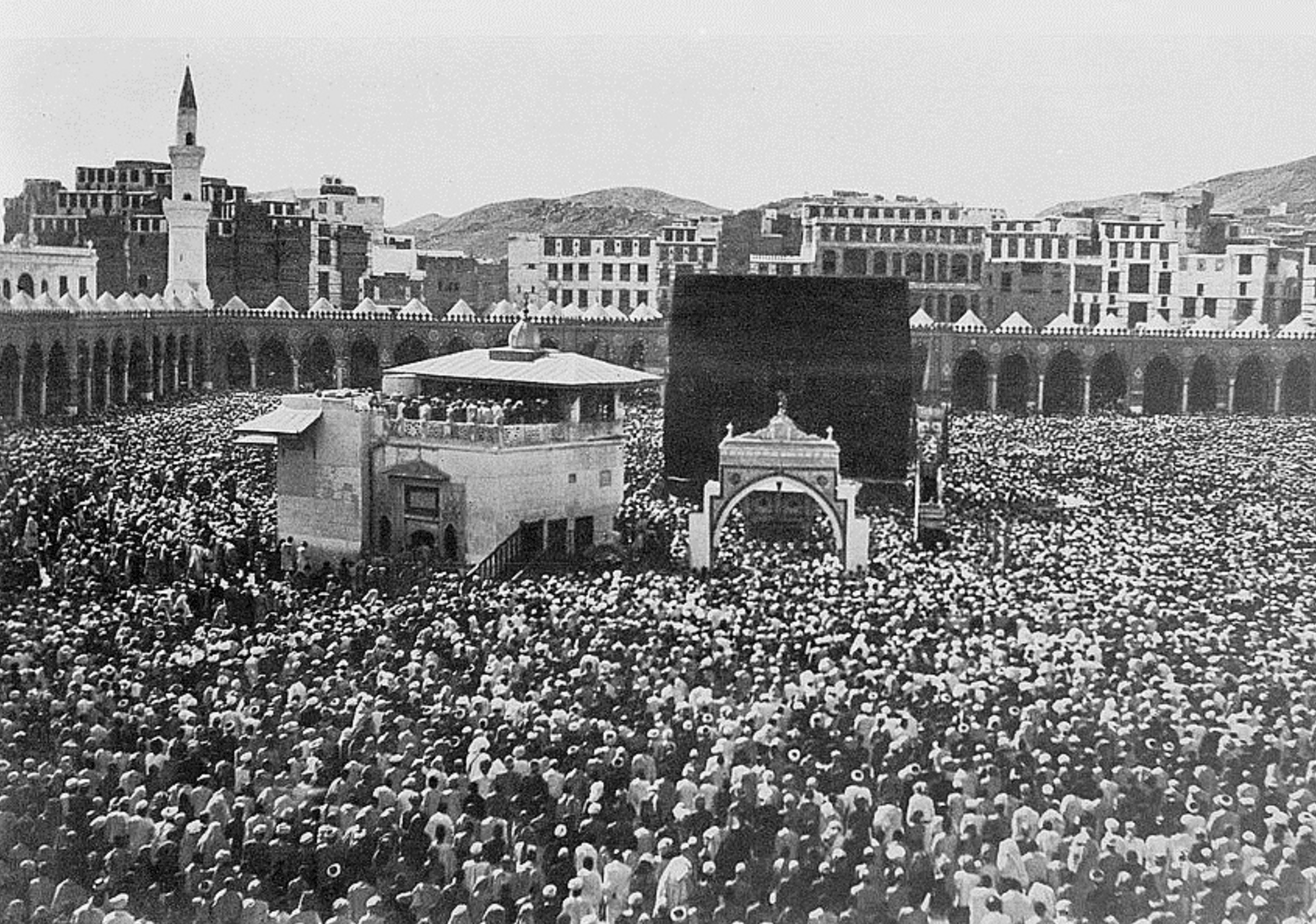
1910. Bird’s-eye view of Ka’bah crowded with pilgrims. Source: G. Eric and Edith Matson Photograph Collection, Library of Congress.
On 19 December 1844, the Báb spent the day of Arafat, the second day of pilgrimage and the day preceding the Islamic holy festival of Eid al-Adha in His room in prayer and meditation. The next day, 20 December 1844, was the first day of the festival and the Báb offered His feast-day prayer and purchased 19 lambs of the finest breed. He offered 9 in sacrifice in His name, 7 in the name of Quddús and 3 in the name of Ḥájí Mubárak. The Báb did not partake of the feast, preferring instead to distribute it among the poor in the neighborhood.
Because of the oppressive heat, the pilgrims had to wear light, loose-fitting tunics instead of the traditional pilgrim attire. The Báb refused to remove His turban or cloak, as a mark of respect, and performed all the rites of pilgrimage dressed in His regular attire, circumambulating the Ka’bih.
Among the most distinguished pilgrims that year, was Siyyid Ja’far-i-Kashfí, the father of Vaḥíd. Vaḥíd, then known as Siyyid Yaḥyá, was one of the most erudite men of Persia and would soon become one of the Báb’s most distinguished followers.
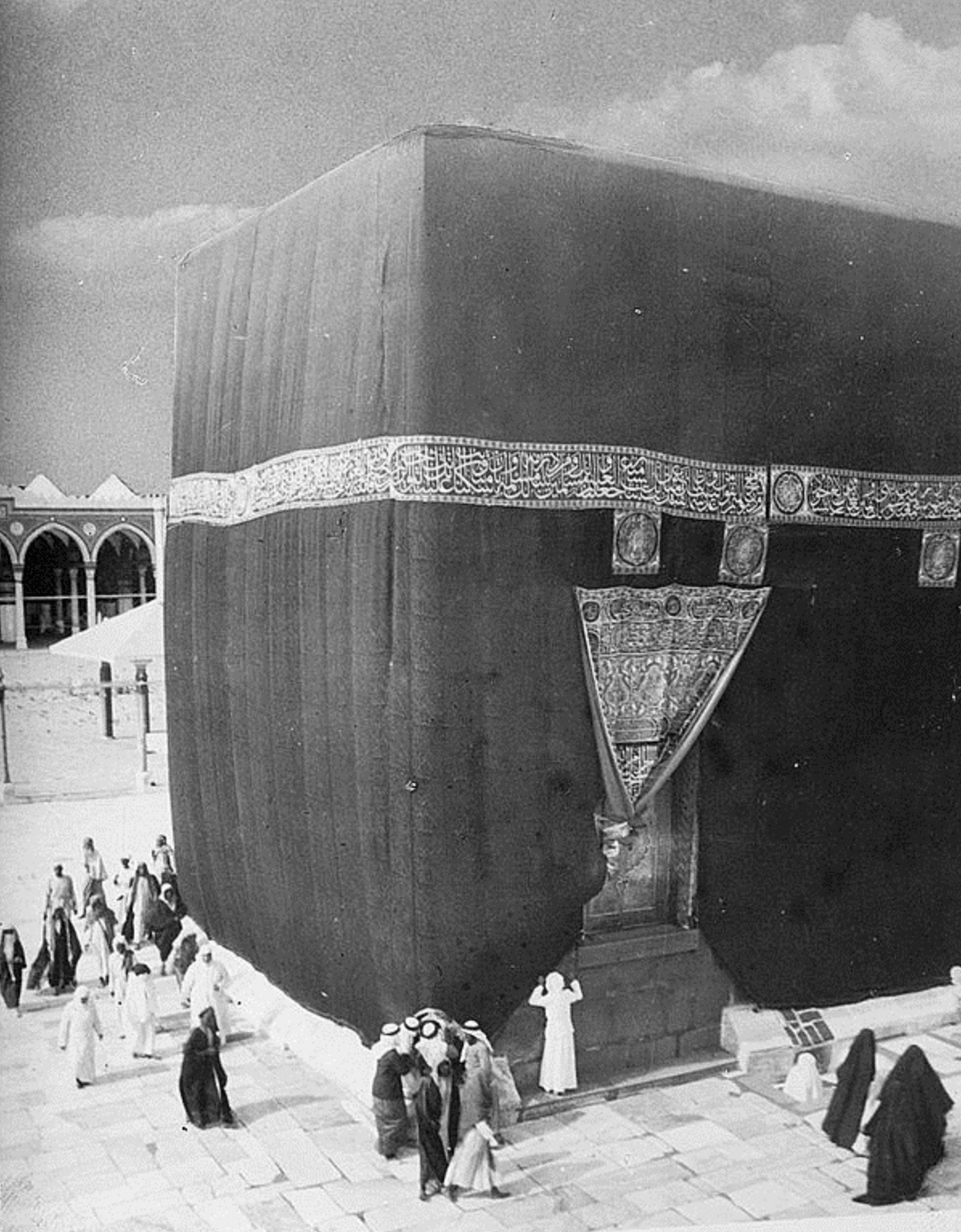
1910. Closeup of the Kaaba, with a man touching it. Source: G. Eric and Edith Matson Photograph Collection, Library of Congress.
At the center of the holiest mosque of Islám is the Ka’bih, a black cubic structure, considered the most sacred site in Islám. For Muslims, it is the House of God, and it is also their qiblih, the point towards which all Muslims around the world turn to for the recitation of their obligatory prayers.
After the Báb had completed the rites of pilgrimage, and at a time when the court of the House of Ka’bih and the roofs of adjoining houses were swarming with 100,000 pilgrims, the Báb stood against the structure of the Ka’bih, took the ring on its door in His hands and repeated three times in a clear voice:
“I am that Qá'im whose advent you have been awaiting.”
The crowd fell silent.
The Qá’im, the Promised One of Islám, awaited for a thousand years and yearned for by forty generations of Muslims had just been announced at the holiest spot in all of Islám.
News of the young Siyyid’s claim started spreading, and would soon arrive in Shíráz.
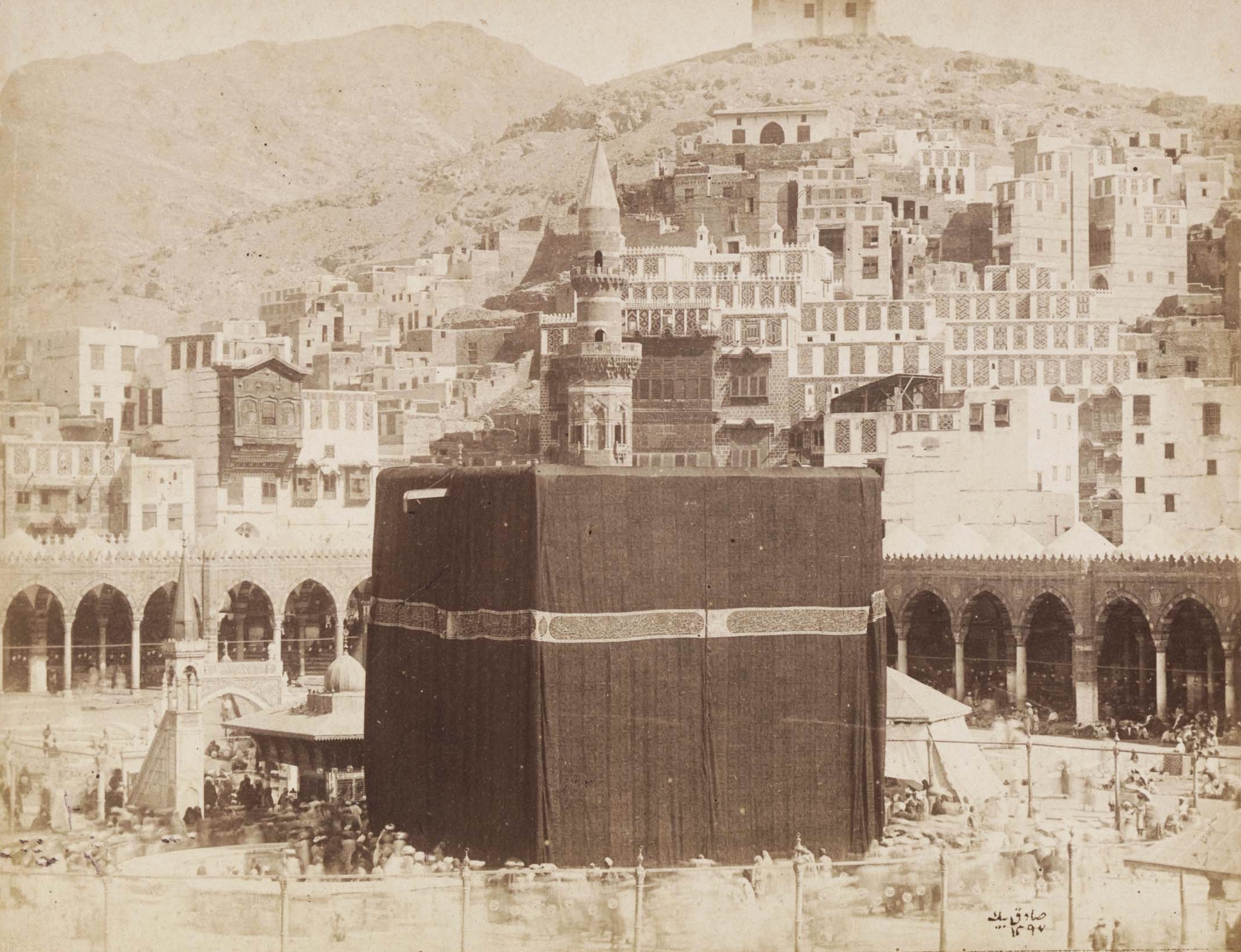
The Ka’bah photographed in 1880, just 36 years after the Báb was on pilgrimage and the story below takes place. The photograph is by Muhammad Sadiq Bey, who was the first person to take photographs of Mecca, Medina and the Hajj. An Egyptian army engineer and surveyor, he was also the treasurer of the Egyptian Hajj caravan. Source: Wikimedia Commons.
On the last day of His pilgrimage to Mecca, the Báb met the haughty Mírzá Muhít-i-Kirmání, one of the most outstanding exponents of the Shaykhí school.
This encounter, where the Báb declared His mission and issued an open challenge to Mírzá Muhít, was one of the two most significant events during the Báb’s pilgrimage. Mírzá Muhít-i-Kirmání was facing the Black Stone, when the Báb approached him, took his hands in His, and said:
“O Muhit! You regard yourself as one of the most outstanding figures of the Shaykhí community and a distinguished exponent of its teachings. In your heart you even claim to be one of the direct successors and rightful inheritors of those twin great Lights, those Stars that have heralded the morn of Divine guidance. Behold, we are both now standing within this most sacred shrine. Within its hallowed precincts, He whose Spirit dwells in this place can cause Truth immediately to be known and distinguished from falsehood, and righteousness from error. Verily I declare, none besides Me in this day, whether in the East or in the West, can claim to be the Gate that leads men to the knowledge of God. My proof is none other than that proof whereby the truth of the Prophet Muḥammad was established. Ask Me whatsoever you please; now, at this very moment, I pledge Myself to reveal such verses as can demonstrate the truth of My mission. You must choose either to submit yourself unreservedly to My Cause or to repudiate it entirely. You have no other alternative. If you choose to reject My message, I will not let go your hand until you pledge your word to declare publicly your repudiation of the Truth which I have proclaimed. Thus shall He who speaks the Truth be made known, and he that speaks falsely shall be condemned to eternal misery and shame. Then shall the way of Truth be revealed and made manifest to all men.”
Mírzá Muhít-i-Kirmání was profoundly distressed by the Báb’s open challenge, issued with so much majesty and force. Scared and confused, he swore his fealty to the Báb, and swore to arise for the Triumph of the Cause. He ended by saying:
“If I be insincere in what I declare, if in my heart I should disbelieve what my lips proclaim, I would deem myself utterly unworthy of the grace of the Prophet of God, and regard my action as an act of manifest disloyalty to ‘Alí, His chosen successor.”
The Báb listened attentively to his words, but harbored no illusion about the man’s weakness of character. Nevertheless, He offered to answer Mírzá Muhít-i-Kirmání’s questions before His departure from Medina as conclusive proof of His truth. The faithless Mírzá Muhit submitted his questions to the Báb, and left in haste.
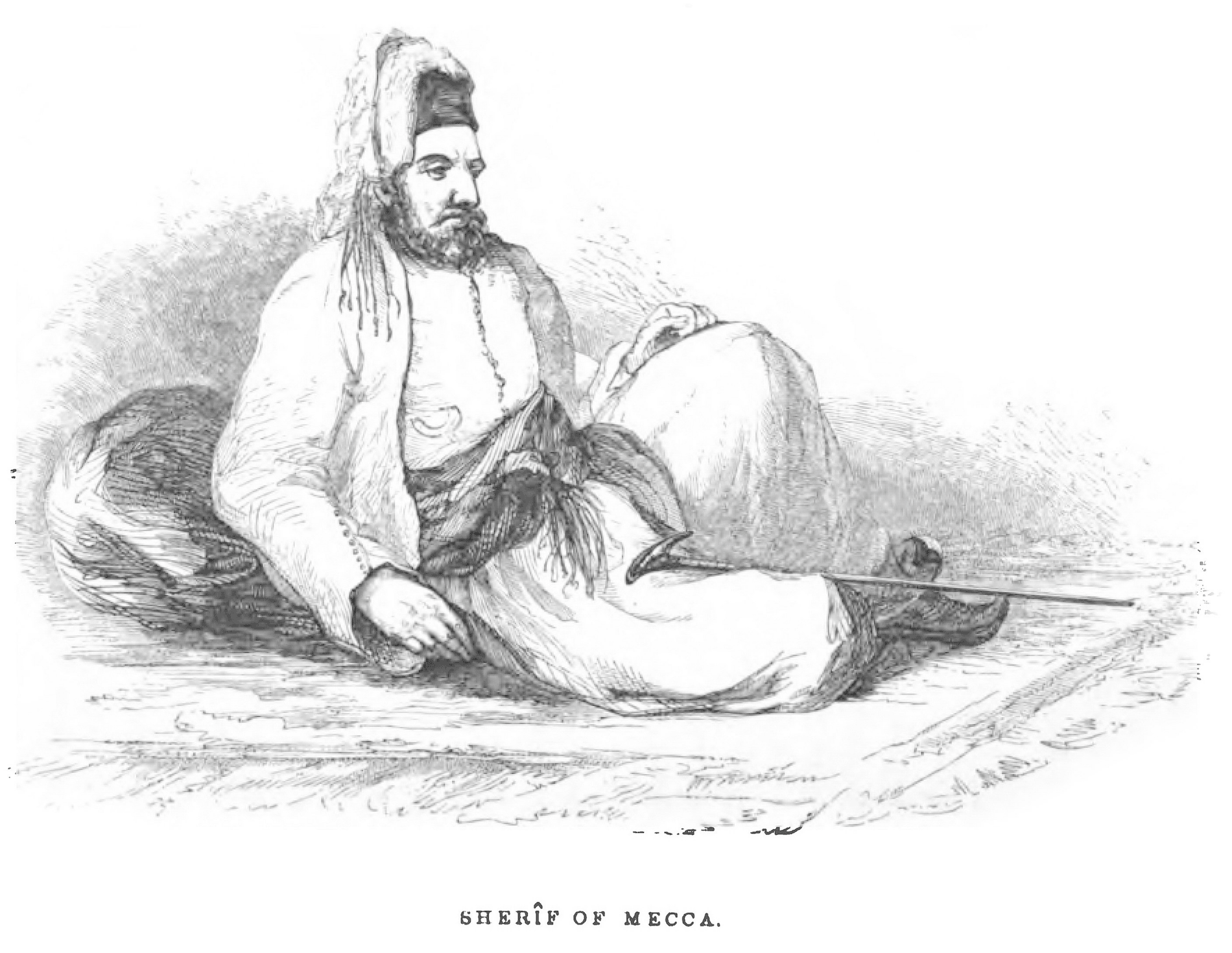
Sherif of Mecca, drawing from 1849, five years after he met the Báb, drawn by William Francis Lynch (Commander U.S.N.). Muḥammad ibn 'Abd al-Mu'ín ibn 'Awn was the Sherif and Emir of Mecca from 1827 to 1851 and 1856 to 1858. He was appointed to the Emirate in 1827 by Muhammad Ali Pasha, the ruler of Egypt. Source: Wikimedia Commons.
The second most significant event to take place during the Báb’s pilgrimage was the Tablet He addressed to the Sherif of Mecca, and which Quddús delivered, along with selections from the Báb’s Writings.
In His Tablet to the Sherif of Mecca, the Báb set forth clearly and unmistakably, the distinguishing features of His mission and invited him to arise and embrace the truth of His new Revelation. The Báb’s invitation fell on deaf ears and the Sherif did not reply.
Six years later, in 1850, shortly after the martyrdom of the Báb, the Sherif of Mecca would recount this episode to a pilgrim named Ḥájí Níyáz-i-Baghdádí, and their conversation adds further details to the story. The Sherif recalled that the Báb came to him the following day, asking if he had any response to His offer:
“I recollect that in the year ’60 [1844], during the season of pilgrimage, a youth came to visit me. He presented to me a sealed book which I readily accepted but was too much occupied at that time to read. A few days later I met again that same youth, who asked me whether I had any reply to make to his offer. Pressure of work had again detained me from considering the contents of that book. I was therefore unable to give him a satisfactory reply. When the season of pilgrimage was over, one day, as I was sorting out my letters, my eyes fell accidentally upon that book. I opened it and found, in its introductory pages, a moving and exquisitely written homily which was followed by verses the tone and language of which bore a striking resemblance to the Qur’án. All that I gathered from the perusal of the book was that among the people of Persia a man of the seed of Fáṭimih and descendant of the family of Háshim, had raised a new call, and was announcing to all people the appearance of the promised Qá’im. I remained, however, ignorant of the name of the author of that book, nor was I informed of the circumstances attending that call.”
When Ḥájí Níyáz-i-Baghdádí informed him of the station of the Báb, His distinguished lineage, the breadth of His Revelation, the scope of His influence and the circumstances of His martyrdom, the Sherif exclaimed:
“The malediction of God be upon these evil people,’ he exclaimed, ‘a people who, in days past, treated in the same manner our holy and illustrious ancestors!”
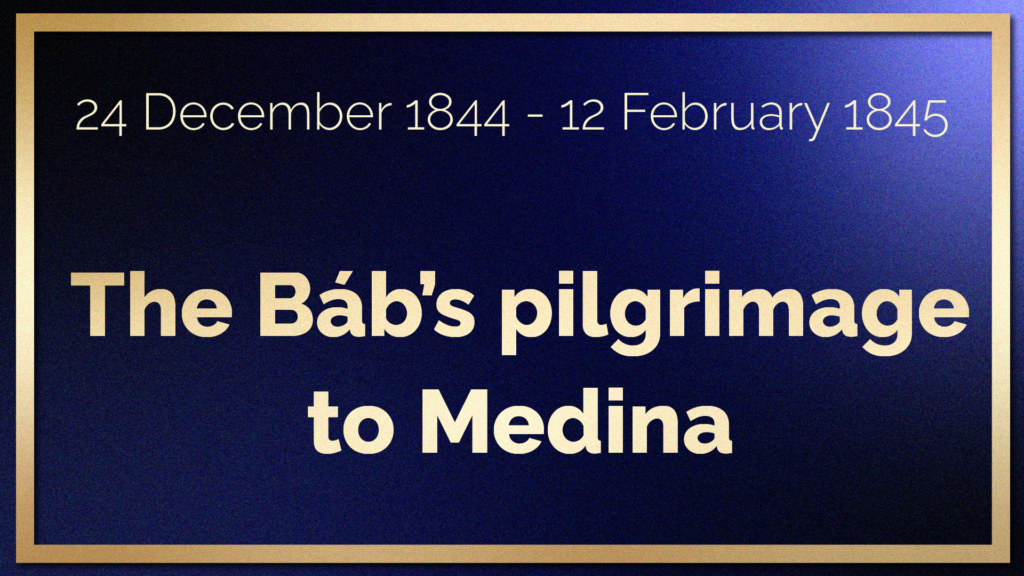
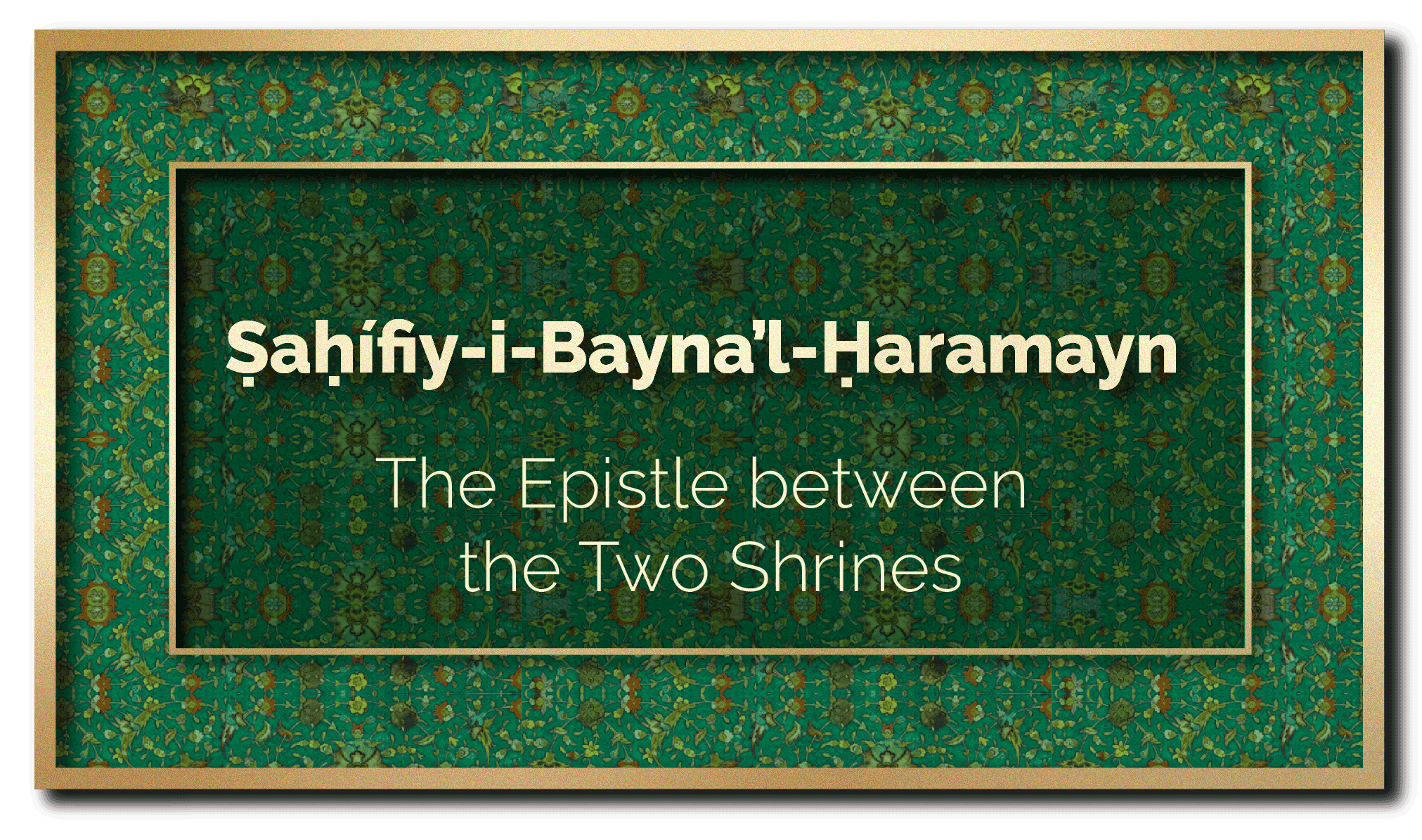
The Báb left Mecca on 7 January 1845, and faithful to His promise, He revealed His response to Mírzá Muhít-i-Kirmání and Siyyid ‘Alíy-i-Kirmání’s questions three days later, on His way from Mecca to Medina in a Tablet called Ṣaḥífiy-i-Bayna’l-Ḥaramayn (The Epistle between the Two Shrines).
The Báb revealed the Ṣaḥífiy-i-Bayna’l-Ḥaramayn with an introduction and 7 chapters, affirming His station, answering various questions having to do with talismanic symbols, and including prayers and Tablets of Visitation associated with pilgrimage to the shrine of the Imám Ḥusayn.
Mírzá Muhít received the Tablet soon after arriving in Karbilá and was unmoved by its tone or content, refusing to recognize the teachings laid out by the Báb. He would demonstrate concealed and persistent opposition to the Bábí Faith for years to come.
Partial Inventory ID: BB00019
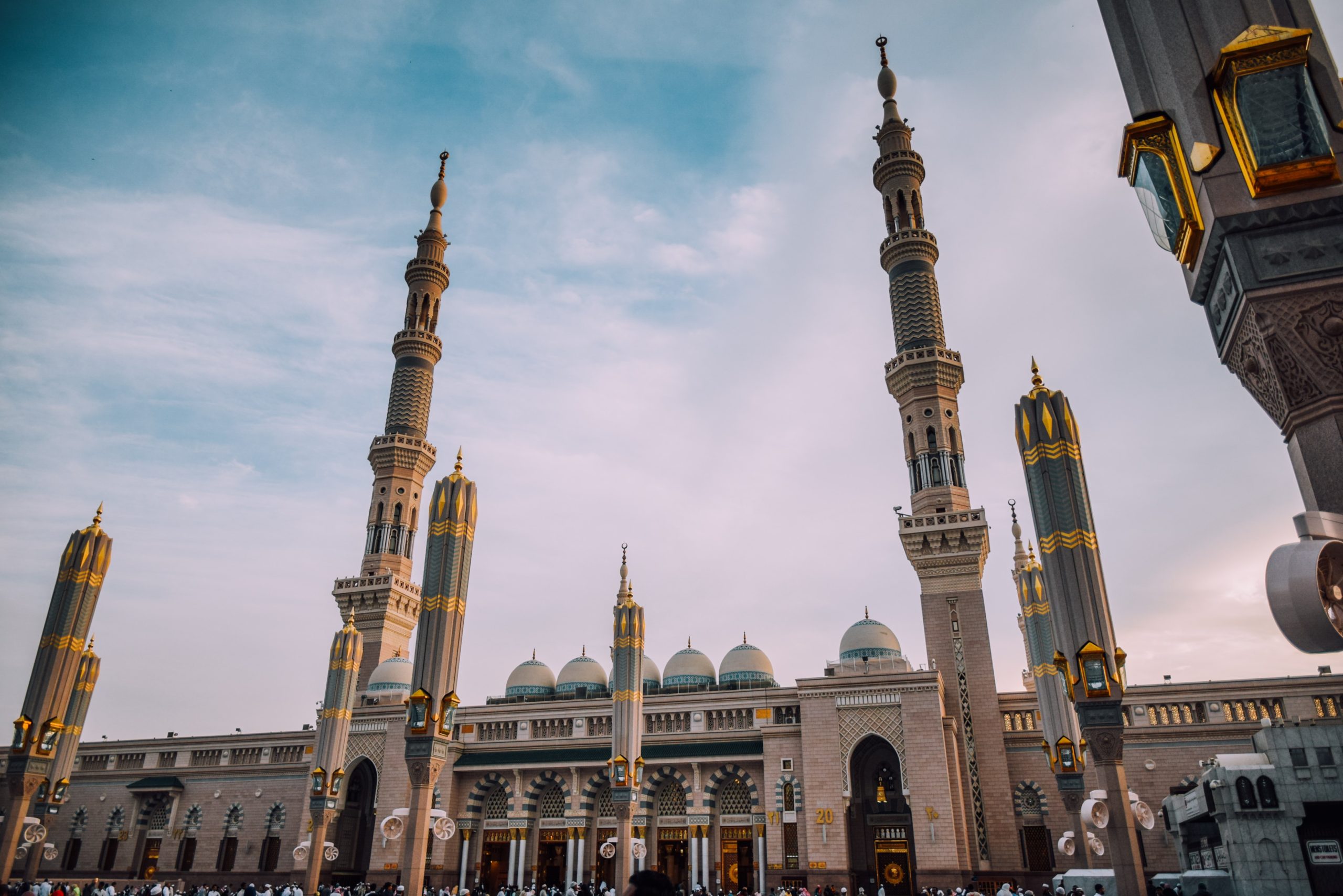
Al-Masjid al-Nabawi (“The Prophet's Mosque”), where the Prophet Muḥammad is laid to rest in Medina. Photo by Yasmine Arfaoui on Unsplash
After leaving Mecca, the Báb left for Medina, the next stage in His pilgrimage, where He arrived on 16 January 1845.
Medina is the second holiest city in Islám, and widely considered to be the cradle of Muslim culture and civilization.
The importance of Medina in Islám and the reason it is the second city for pilgrimage rests on a mosque called Al-Masjid al-Nabawi (“The Prophet's Mosque”), a mosque of exceptional importance to Muslims because it was not only built by the Prophet Muḥammad, but it is where He was laid to rest.
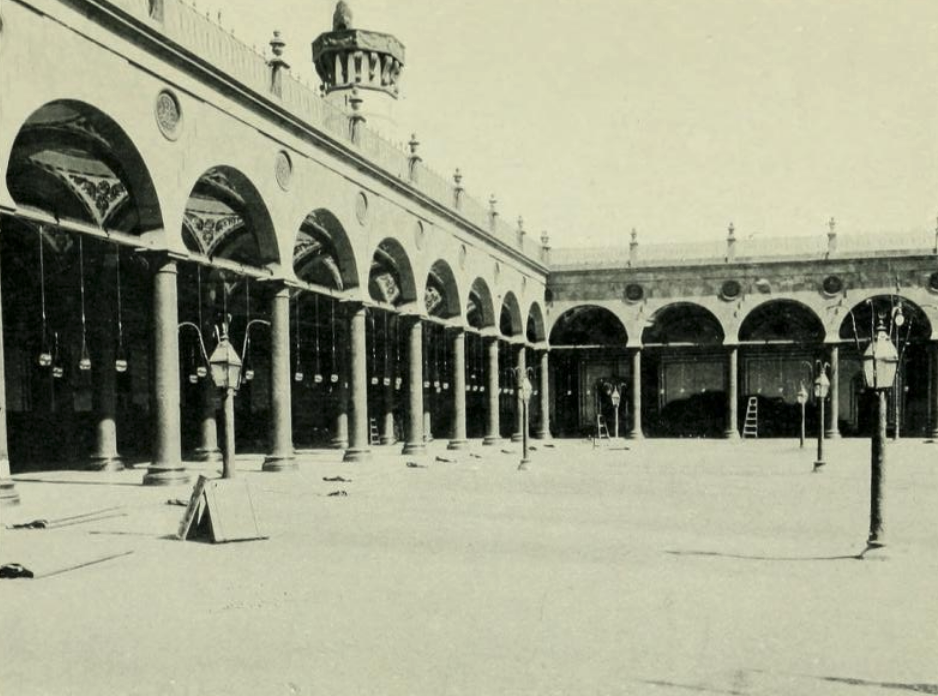
Court of the mosque at Medina from a photograph by Gervais-Courtellemont in “L’Illustration,” October 3, 1908. Source: Augustus Ralli, Christians at Mecca between pages 20 and 21, frontispiece from Archive.org.
As the Báb approached the holy city, He called to mind the stirring events of Islamic history that had immortalized it, and the circumstances of the life and death of the Prophet Muḥammad within its walls.
It was as if He could see these immortal events reenacted before His eyes as He approached the Holy tomb, enshrining the Prophet Muḥammad’s sacred remains.
In approaching Medina, the Báb also remembered Shaykh Aḥmad-i-Aḥsá’í, the Herald of His own Dispensation, who, after handing over His school in Karbilá to Siyyid Káẓim, had made the choice to spend what remained of His life in Medina, in the vicinity of this holiest of shrines. He was buried in the Jannat al-Baqí the oldest and the first Islamic cemetery of Medina.
Nabíl states that the Báb also had visions of Islamic holy men, pioneers and martyrs of the Faith who had fallen in battle, and sealed with their blood the triumph of Islám, thirteen centuries ago. With the Báb’s arrival in Medina, it was as if their sacred dust came alive under His blessed footsteps, their spirit reanimated by His presence, as if their very souls had risen with His approach, and they were hurrying towards Him, welcoming Him to the Holy City.
The Báb’s invincible spirit replied to these visions:
“Fear not, I am come into this world to bear witness to the glory of sacrifice. You are aware of the intensity of My longing; you realise the degree of My renunciation. Nay, beseech the Lord your God to hasten the hour of My martyrdom and to accept My sacrifice. Rejoice, for both I and Quddús will be slain on the altar of our devotion to the King of Glory. The blood which we are destined to shed in His path will water and revive the garden of our immortal felicity. The drops of this consecrated blood will be the seed out of which will arise the mighty Tree of God, the Tree that will gather beneath its all-embracing shadow the peoples and kindreds of the earth. Grieve not, therefore, if I depart from this land, for I am hastening to fulfil My destiny.”
Medina marked the end of the Báb’s pilgrimage. The Báb, Quddús, and Ḥájí Mubárak left Medina on 12 February 1845, arrived in Jidday twelve days later on 24 February and embarked three days later, on 27 February 1845, bound for Búshihr.
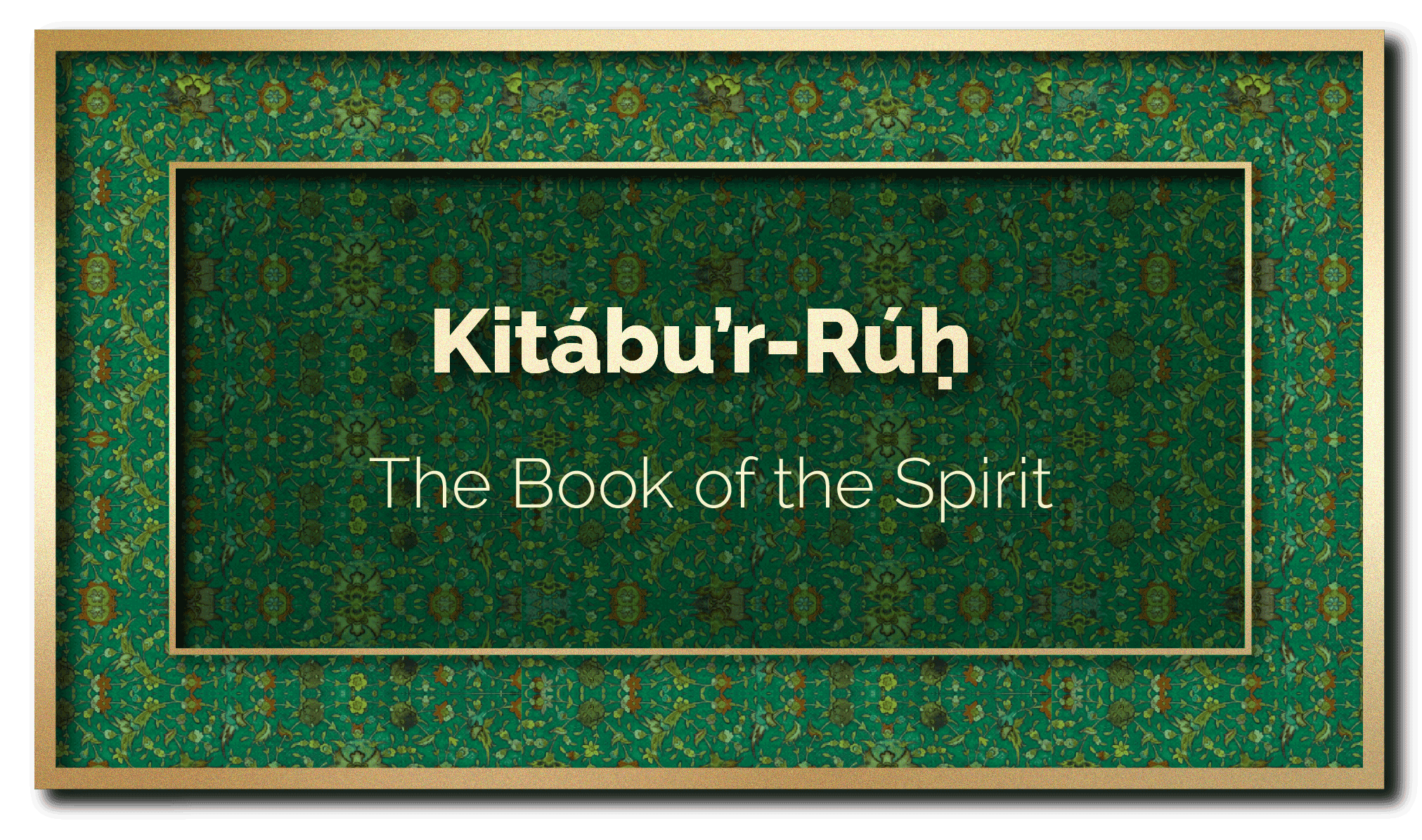
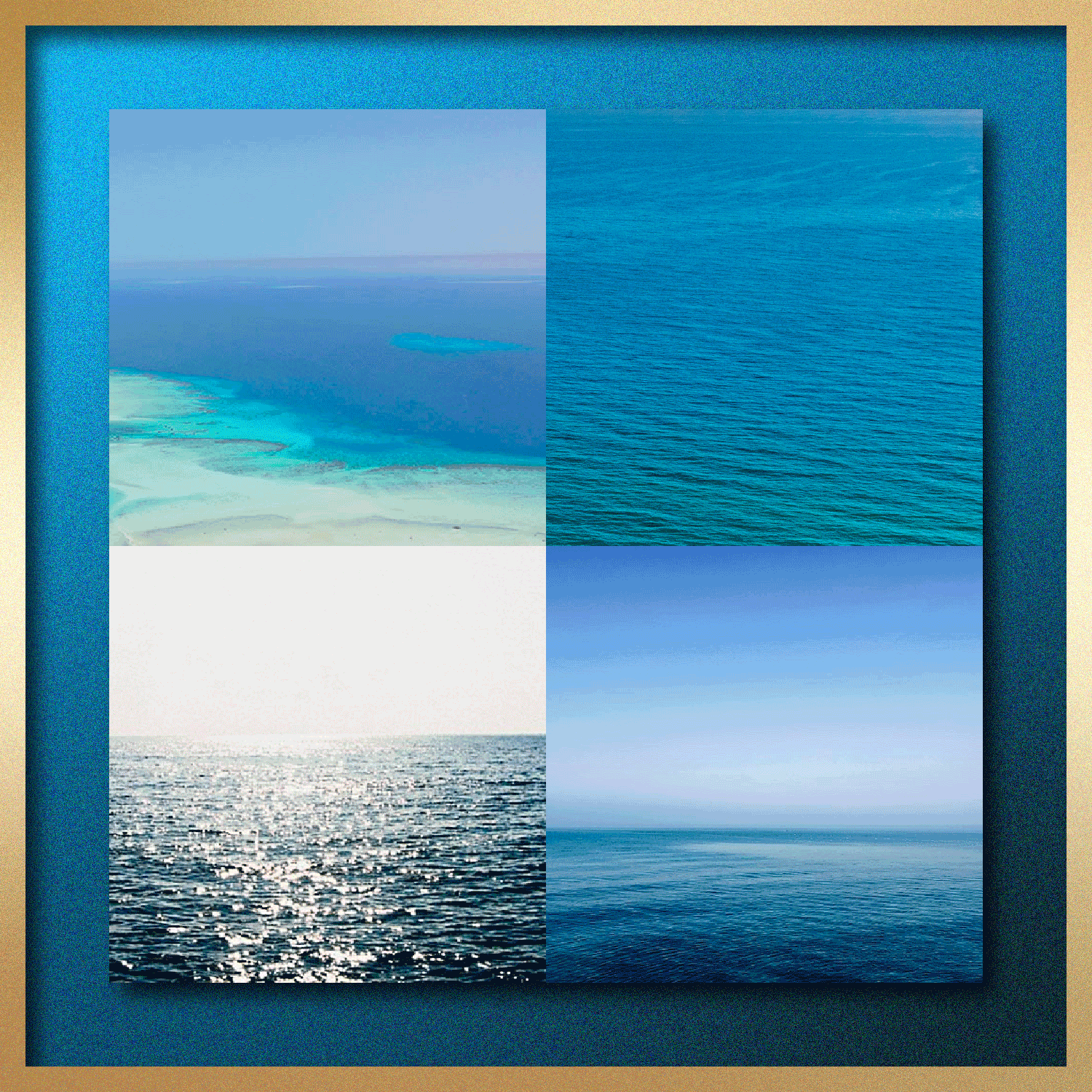
“Four seas”: A collage of four photos of the four bodies of water, in order, sailed by the Báb on His return to Búshihr, emphasizing the contact with the elements that the Báb had while revealing the Book of the Spirit over open seas: Top left: The Red Sea; Top right: The Gulf of Aden; Bottom left: The Arabian Sea; Bottom right: The Persian Gulf. Design: © Violetta Zein
While He was sailing back to Búshihr after His pilgrimage with Quddús and Ḥájí Mubárak, the Báb revealed the Kitábu’r-Rúḥ (Book of the Spirit), a lengthy book of 700 short súrihs written in the language of the Qur’án.
In this important book, the Báb interprets the Qur’ánic prophecy of the descent of the Spirit, identifying Himself with Jesus Christ and the Holy Spirit.
The Báb revealed the Kitábu’r-Rúḥ in close contact with the elements, and they appear frequently in the book as the Báb mentions the beauty of nature, the wind, waves, dawn, and sunshine, interpreting their ultimate spiritual meaning as symbols of man’s inner spiritual journey to the truth of God, and the Revelation of the Báb Himself.
Partial Inventory ID: BB00009
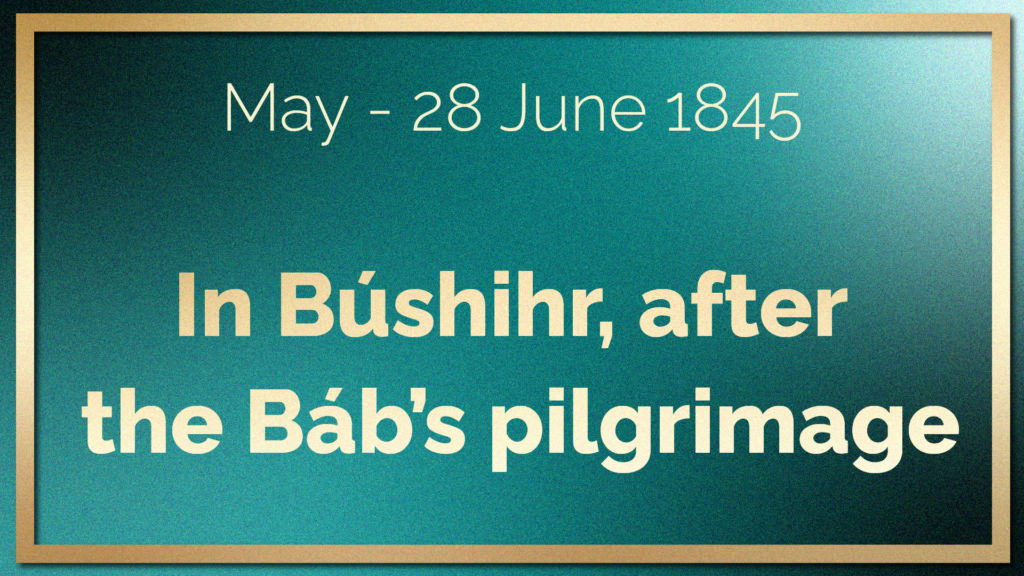
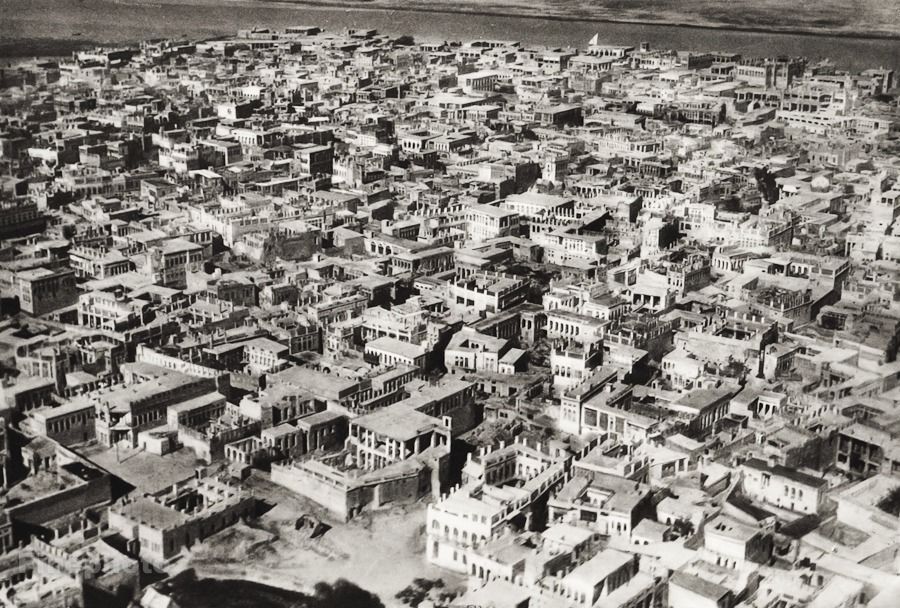
Búshihr city in 1934, photographed by Walter Mittelholzer. Source: Wikimedia Commons.
The Báb arrived in Búshihr after His pilgrimage sometime in March 1845.
In Búshihr, the Báb sent Quddús to Shíráz on a mission to deliver a Tablet from the Báb to His uncle Ḥájí Mírzá Siyyid ‘Alí and bid him farewell, saying:
“The days of your companionship with Me are drawing to a close. The hour of separation has struck, a separation which no reunion will follow except in the Kingdom of God, in the presence of the King of Glory.”
When the Báb’s uncle, Ḥájí Mírzá Siyyid ‘Alí, received the Báb’s Tablet from the hands of Quddús, he was immediately convinced of the truth of His Cause and instantly pledged allegiance to the Báb.
Ḥájí Mírzá Siyyid Muḥammad, the Báb’s uncle who lived in Búshihr, welcomed the Báb home and sent a letter to His family in Shíráz:
“It has gladdened our hearts that His Honour the Ḥájí [the Báb] has arrived safely and is in good health. I am at His service and honoured to be in His company. It is deemed advisable that He should stay here for a while. God willing, He will, before long, honour those parts with His presence, be assured.... His blessed Person is our glory. Be certain of His Cause and do not let people's idle talk cause doubts to creep into your hearts. And have no fear whatsoever. The Lord of the world is His Protector and gives Him victory....”
At the end of his letter Ḥájí Mírzá Siyyid Muḥammad added a message from his wife to the mother of Khadíjih Bagum:
“You have a son-in-law who is peerless in the world. All the peoples of the world ought to obey Him.”
Ḥájí Mírzá Siyyid Muḥammad wrote another letter to his family shortly after where He quoted something the Báb had said:
“ My proof is My Book—let him who can, produce the like of these verses.”
The Declaration of the Báb’s mission was steadily unfolding.
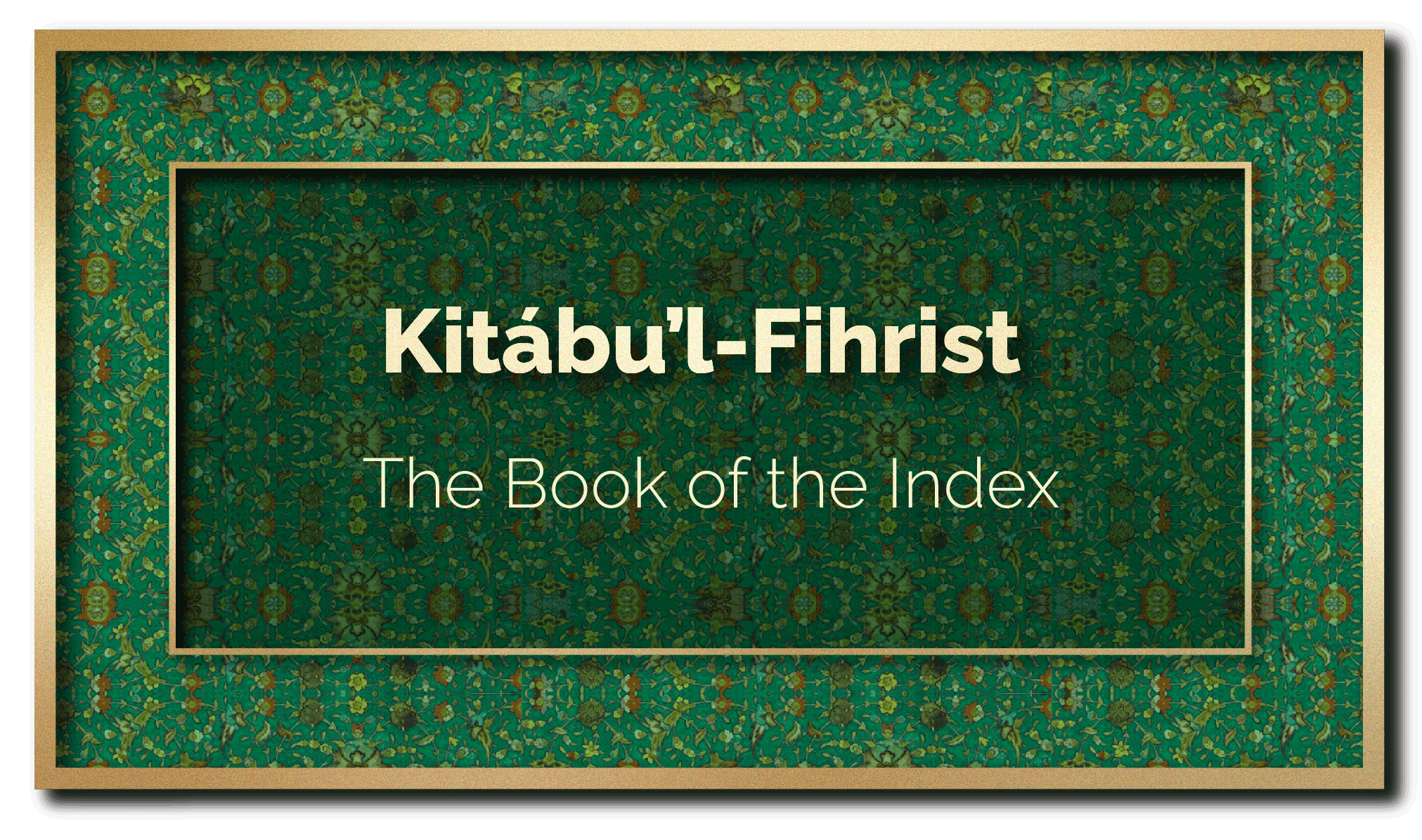
A few months after arriving in Búshihr following His pilgrimage to Mecca and Medina, the Báb revealed an immensely important book, the Kitábu’l-Fihrist (Book of the Index).
It is vital to remember that although we are addressing the Kitábu’l-Fihrist separately, it was intended to be the second sermon in the compilation of 14 sermons that compose the work the Báb started revealing while on pilgrimage to Mecca and Medina, in early 1845, namely the Ṣaḥífiy-i-Raḍavíyyih (Epistle of Riḍá’).
The Kitábu’l-Fihrist is significant as it is one of two listings the Báb made of His own revealed Writings, the other being the Khuṭbiy-i-Dhikríyyih, which we look at later in the chronology at the end of January 1846.
The Kitábu’l-Fihrist is an index of the works revealed in the first 13 months of His ministry, until 21 June 1845.
An interesting aspect of the Book of the Index constituted a turning point in the Báb’s mission. In drawing up the list of His Revelation until that point, the Báb’s intent, announced in the Book, to withdraw from contact and put a stop to Revelation for a period of five years starting on 21 June 1845. The Báb identified Mullá Ḥusayn as the one to whom all questions regarding His Writings should be directed.
The reason for the Báb’s intended withdrawal was that His Proclamation and message had been received with opposition, denial and persecution. The Báb was never able to follow through with His intent of withdrawing and ceasing to answer any questions, which He had stated elsewhere in letters, and hinted at in person. The passionate insistence of the Bábís, combined with the Báb’s own nature led the Báb to alter that decree.
Coincidentally, it would be five years and 19 days from that exact date that the Báb would be martyred in Tabríz.
Partial Inventory ID: BB00128 also BB00137 (Second sermon)
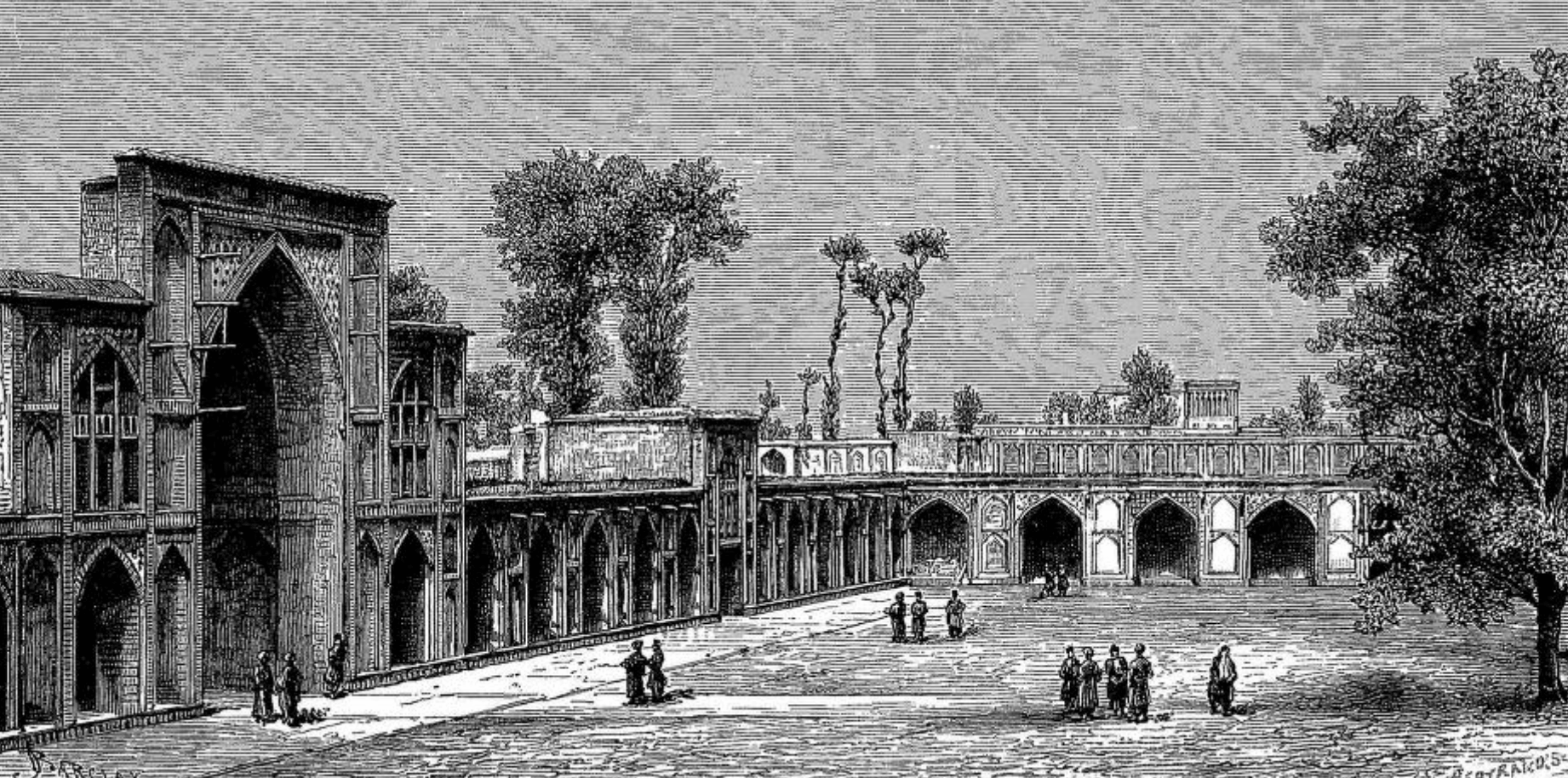
A mosque in Shíráz, as a symbolic illustration of Mullá Ṣádiq-i-Muqaddas changing the call to prayer in the Báqir-Ábád mosque in Shíráz, at the Báb’s request. Source: Jane Dieulafoy, La Perse, la Chaldée et la Susiane, page 450. Source : Archive.org.
From Búshihr, the Báb wrote to Mullá Ṣádiq-i-Muqaddas, a former notable disciple of Siyyid Káẓim, who had been one of Mullá Ḥusayn’s earliest and most outstanding converts in Mashhad.
Mullá Ṣádiq-i-Muqaddas had recently arrived in Shíráz from Masshád with Mullá `Alí-Akbar-i-Ardistání, and had established himself in a mosque called Báqir-Ábád where he had been leading the congregation in prayer.
In the Tablet the Báb sent Mullá Ṣádiq-i-Muqaddas from Búshihr, He had included specific instructions to include this additional line in the traditional call to prayer:
“I bear witness that He whose name is `Alí Qabl-i-Muḥammad [`Alí preceding Muḥammad, the Báb] is the servant of Baqíyyatu'lláh [the Remnant of God, Bahá'u'lláh].”
As soon as Mullá Ṣádiq-i-Muqaddas received these instructions, he moved to the mosque that was next to his house and implemented the change in the call to prayer.
The storm broke immediately.
Shaykh Abú-Háshim, the one who had almost been thrown overboard for his appalling behavior, and who had been saved by the Báb Himself, had been busy inciting anger against the Báb since he had returned from pilgrimage, and now he led the clerics of Shíráz to demand blood for the outrage of the change to the the call to prayer.
Quddús, Muqaddas and Mullá `Alí-Akbar were arrested, brought before Ḥusayn Khán, the Governor-General of Shíráz, and mercilessly beaten. In doing so, Ḥusayn Khán became the very first Persian official to attack the followers of the Báb.
By the end of June, the Báb was on His way back to Shíráz.
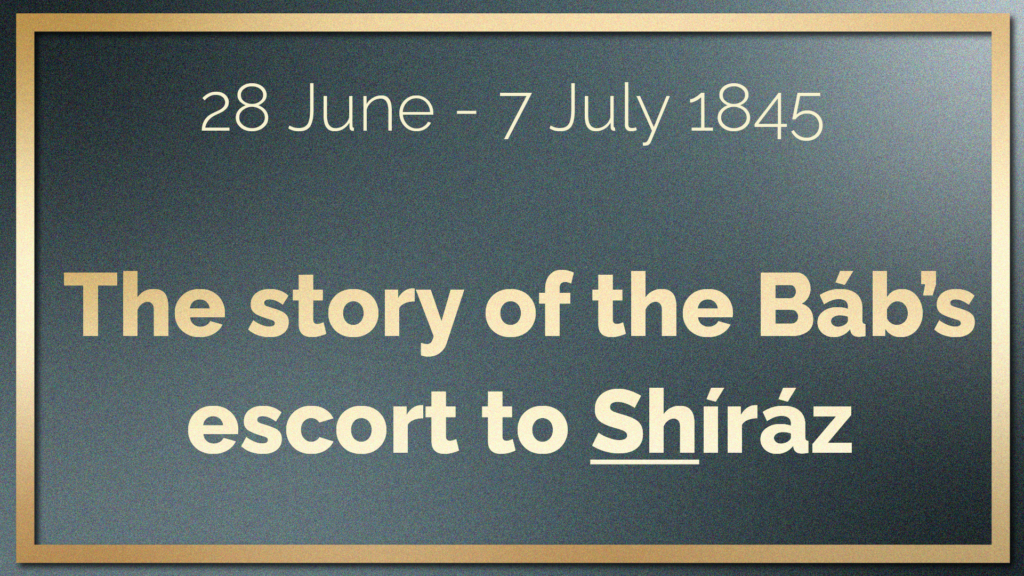
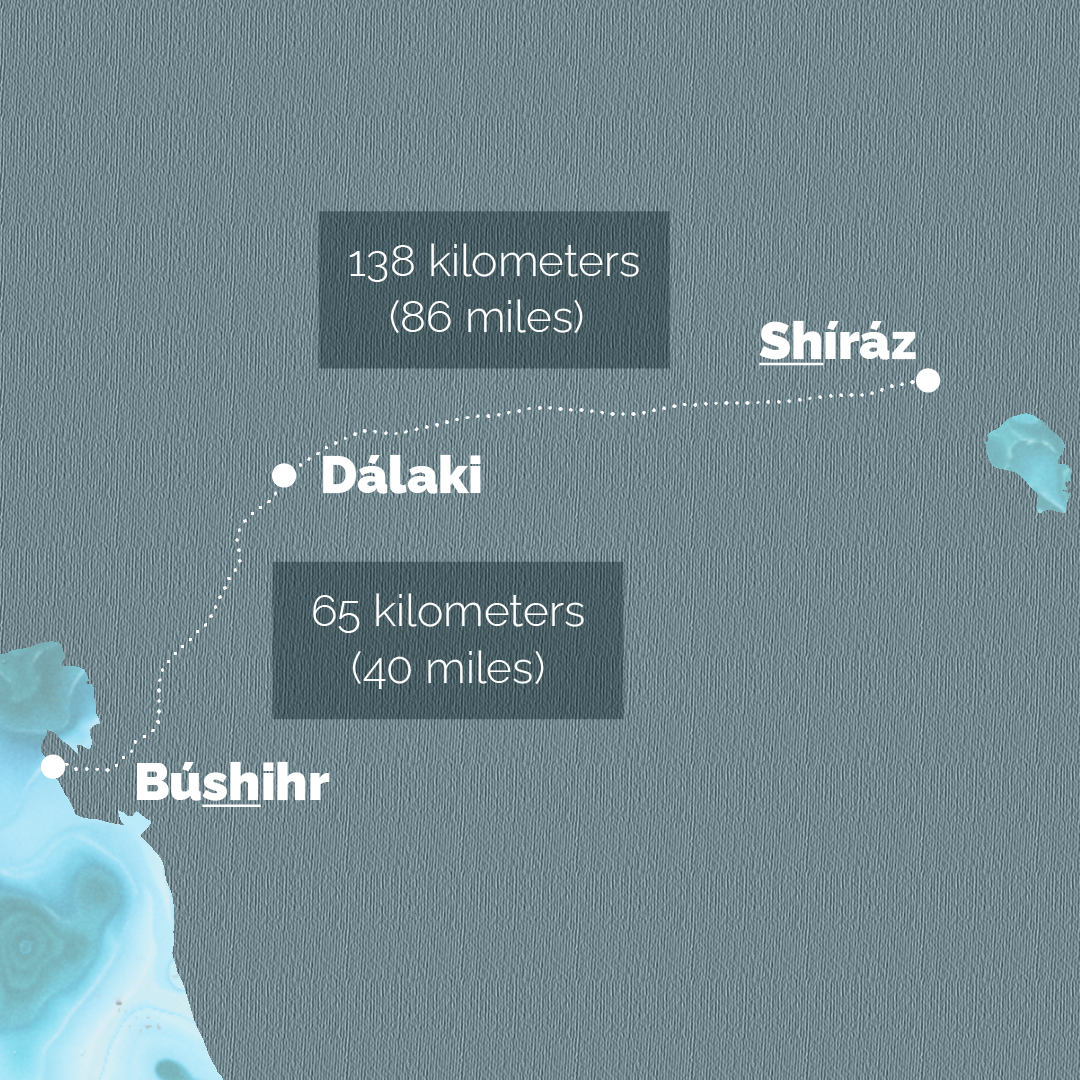
Map of the distances between Búshihr, Dálaki and Shíráz, showing the Báb's journey to His native city after an eight-month absence. The drawn route is symbolic. © Violetta Zein
The arrest and beating of Quddús, Muqaddas and Mullá `Alí-Akbar happened as Shíráz had lived for almost a year under total chaos, anarchy of crimes, thieving and public disturbance, which had swelled since the Báb had left for pilgrimage.
When Ḥusayn Khán discovered the identity of the Báb and found He was in Búshihr, he commissioned mounted officers to arrest Him and bring Him back to Shíráz.
The Báb had left Búshihr en route to Shíráz on 28 June 1844, and two days later had reached Dálaki, some 65 kilometers (40 miles) northeast of Búshihr when He encountered Ḥusayn Khán’s mounted guards.
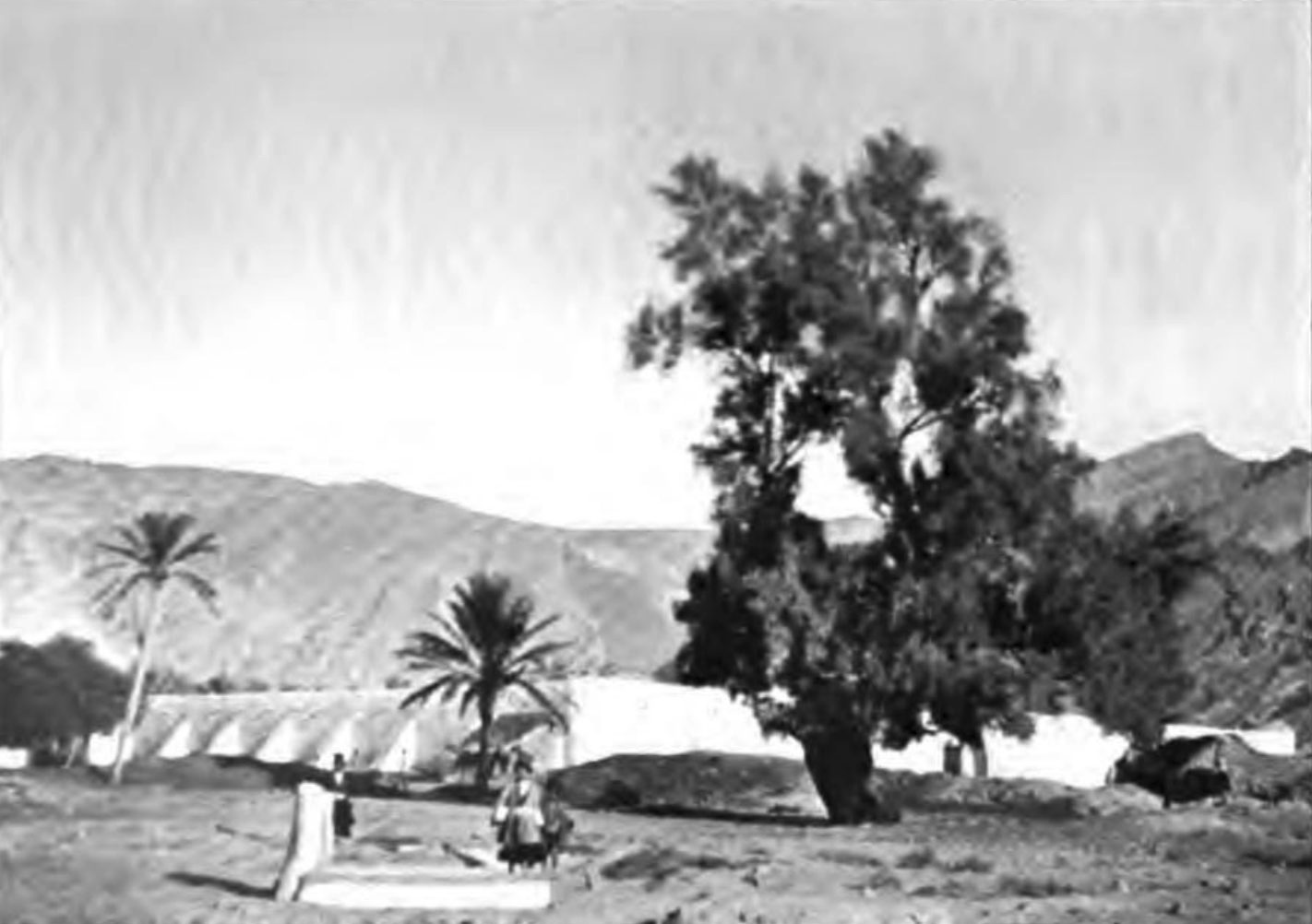
Dálaki, where the Báb met His escort back to Shíráz, from Across Persia by Eliot Crawshay-Williams, between pages 52 and 53. Source: Internet Archive.
The Báb was the first to see the horsemen and He instructed Ḥájí Mubárak:
“Go quickly and ask the soldiers where they are going and what their mission is.”
Ḥájí Mubárak walked up to the soldiers and attempted to relay the Báb’s message, but the men dismissed him very rudely:
“Where we are going and what we are doing is none of your business, black man!”
Ḥájí Mubárak returned to the Báb saying:
“The horsemen refused to say what their mission is.”
Again, the Báb sent Ḥájí Mubárak to the soldiers bearing a simple message:
“Go and tell them to come to Me.”
Ḥájí Mubárak went to the soldiers a second time and conveyed the Báb’s words:
“My Master asked that you should be so kind as to come, so that we can make your acquaintance.”
Aslán Khán, older and wiser than the rest of the soldiers, accompanied Ḥájí Mubárak to rejoin the Báb, but when the Báb asked him about their mission and destination, he also refused to answer. The Báb answered for him:
“No reason to conceal it: your mission is to take the Siyyid-i Báb to Shíráz. Do not trouble yourselves. I stand ready. If you went on to Búshihr according to your orders and passed this village by, you would not accomplish your mission.”
The Báb’s words so thrilled Aslán Khán, that He asked the Báb to flee for Mashhad, and take refuge in the shrine of the Eighth Imám. The Báb refused to leave, saying:
“May the Lord your God requite you for your magnanimity and noble intention. No one knows the mystery of My Cause; no one can fathom its secrets. Never will I turn My face away from the decree of God. He alone is My sure Stronghold, My Stay and My Refuge. Until My last hour is at hand, none dare assail Me, none can frustrate the plan of the Almighty. And when My hour is come, how great will be My joy to quaff the cup of martyrdom in His name! Here am I; deliver Me into the hands of your master. Be not afraid, for no one will blame you.”
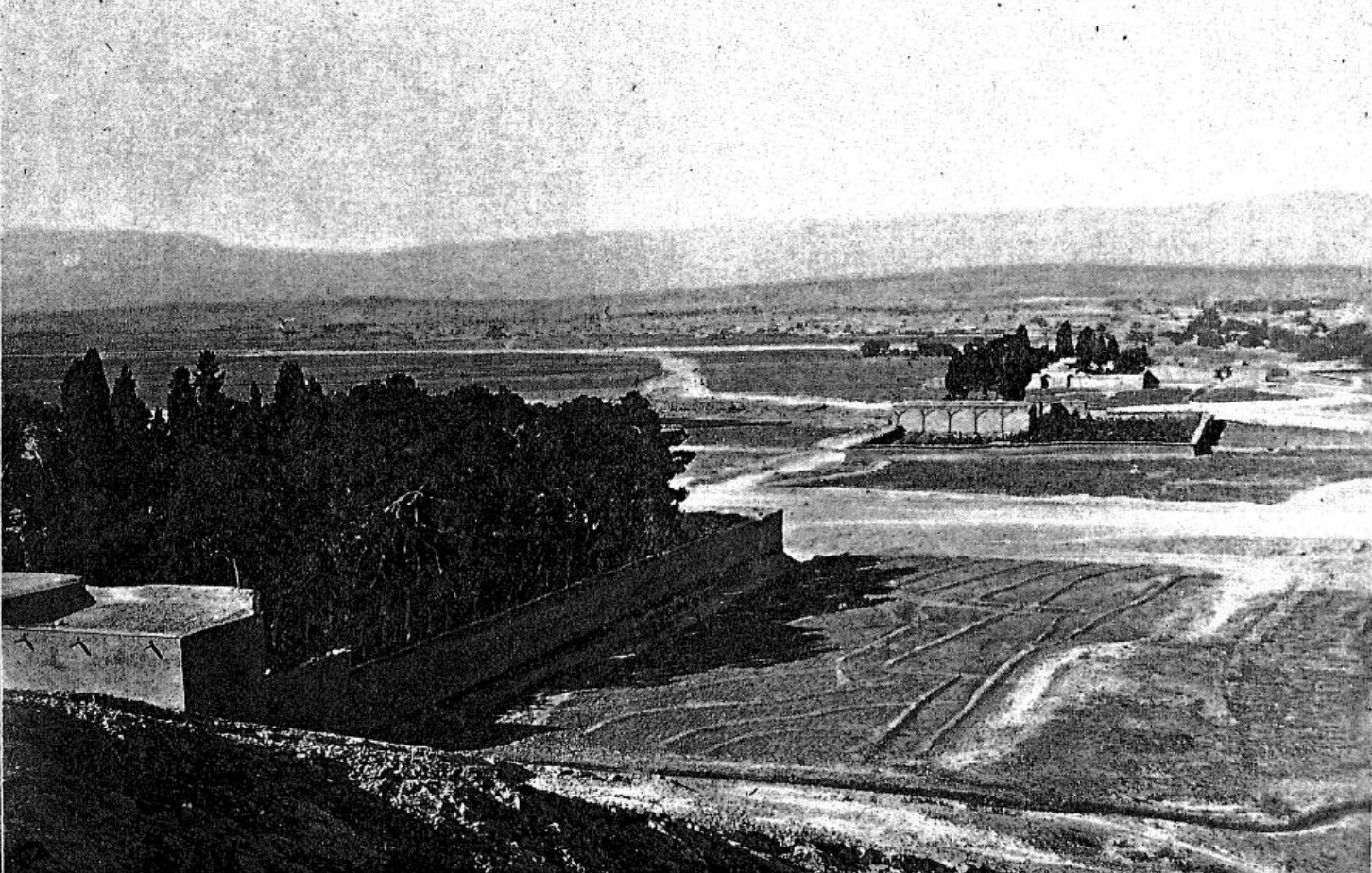
To illustrate the Báb's slow journey to Shíráz, a Panorama of the city from Jane Dieulafoy, La Perse, la Chaldée et la Susiane, page 417. Source : Archive.org.
Although the mounted escort should normally have put the Báb in chains, and brought Him as a captive back to Shíráz, His boldness, courage, and presence had subdued them into reverence.
During their voyage north, Ḥájí Mubárak prepared the meals and fed the soldiers, then with the utmost respect and dignity, the soldiers accompanied the Báb to Shíráz.
What Ḥusayn Khán had intended as a humiliating experience for the Báb had backfired, and He entered Shíráz like a king. His escort, long after they had parted would tell all their friends and acquaintances what they had observed of the grandeur and majesty of the Siyyid-i-Báb.
REFERENCES FOR PART VI
GENERAL NOTE FOR THE DATES OF THE BÁB’S PILGRIMAGE
I would like to thank Dr. Nader Saiedi and Adib Masumian for their help in locating the original Tablet by the Báb listing His dates of pilgrimage which shaped this entire section. The Báb provides a chronology for 11 dates during His journey on pilgrimage to Mecca and Medina, in the Khuṭbiy-i-Jiddah (Sermon of Jiddah) the 11th sermon of Ṣaḥífiy-i-Raḍavíyyih (Epistle of Riḍá’).
You can read the original excerpt of this Tablet on pages 142-145 of Ḥaḍrat-i-Nuqṭiy-i-Úlá, Muḥammad-‘Alí Faizi’s Persian biography of the Báb.
This Sermon has been translated in full by Stephen Lambden in Most Noble Pattern on pages 146-159 (the Báb’s pilgrimage dates are in Part VII, verses 1-15 on pages 152-153).
A bulleted list of the relevant dates from the Báb’s Khuṭbiy-i-Jiddah (Sermon of Jiddah) in English can be found in The Genesis of the Bahá’í and Bábí Faiths in Shíráz and Fárs (Translation of Táríkh Amrí Fárs Va Shíráz), by Mírzá Habibu’llah Afnan, translated and annotated by Ahang Rabbani on page 35, Note 83:
· Departure from Shíráz: 10 September 1844
· Arrival in Búshihr: 19 September 1844
· Departure from the port of Búshihr: 2 October 1844
· Arrival in Mecca: 12 December 1844
· Completion of the Hajj: 24 December 1844
· Departure from Mecca: 7 January 1845
· Arrival in Medina: 16 January 1845
· Departure from Medina: 12 February 1845
· Arrival in Jiddah: 24 February 1845
· Embarkation on ship bound for Persia: 27 February 1845
· Departure for Iran: 4 March 1845
REVELATION: Fi’s-Sulúk II (On the Virtuous Journey II)
Nader Saiedi, Gate of the Heart: Understanding the Writings of the Báb, pages 30, 301-302, and 305.
Before 10 September 1844: Siyyid Javád-i-Karbilá’í
Nabil, The Dawn-Breakers, pages 189-190.
Before 10 September 1844: The Báb hears about Bahá’u’lláh’s conversion
Nabíl, The Dawn-Breakers, pages 126-129.
H.M. Balyuzi, The Báb: The Herald of the Day of Days, page 56.
DATE
From Shoghi Effendi, God Passes By.
10 September 1844: The Báb leaves Shíráz for Búshihr
Nabíl, The Dawn-Breakers, page 126,
Baharieh Rouhieh Ma’ani, Leaves of the Twin Divine Trees, pages 35-36.
FOR THE DATE PLEASE REFER TO THE FIRST REFERENCE ON THIS PAGE: GENERAL NOTE FOR THE DATES OF THE BÁB’S PILGRIMAGE
19 September 1844: The Báb’s first letter to Khadíjih Bagúm
Baharieh Rouhani Ma’ani, Leaves of the Twin Divine Trees, pages 36-37.
Balyuzi, H.M., The Báb: Herald of the Day of Days, page 57.
FOR THE DATE PLEASE REFER TO THE FIRST REFERENCE ON THIS PAGE: GENERAL NOTE FOR THE DATES OF THE BÁB’S PILGRIMAGE
21 September 1844: The Báb’s second letter to Khadíjih Bagúm
Baharieh Rouhani Ma’ani, Leaves of the Twin Divine Trees, pages 36-37.
Balyuzi, H.M., The Báb: Herald of the Day of Days, page 57.
2 October – 10 December 1844: Passengers on the sailing boat to Jaddih
H.M. Balyuzi, The Báb: The Herald of the Day of Days, pages 69-70
DATE
We know the sea journey began on 2 October 1844 from the Báb and from Abbas Amanat, Resurrection and Renewal: The Making of the Bábí Movement in Iran (1844-1850), page 241, we know the sea journey took 71 days, which dates the Báb and His companion’s arrival in Jeddah at 10 December 1844. Jeddah and Mecca were close to each other, and could been reached in two days, which is when the Báb’s pilgrimage began.
2 October – 10 December 1844: Conditions of the sea journey
Nabíl, The Dawn-Breakers, pages 129-131 and footnote 3 in Chapter VII.
Shoghi Effendi, God Passes By.
H.M. Balyuzi, The Báb: The Herald of the Day of Days, page 71.
14 October 1844: Anchored in Musqat
Nabíl, The Dawn-Breakers, pages 129-131 and footnote 2 in Chapter VII.
21 November 1844, in Mukhá: The Báb’s letter to Fáṭimih Bagum
Baharieh Rouhieh Ma’ani, Leaves of the Twin Divine Trees, pages 8-9.
Baharieh Rouhani Ma’ani, Leaves of the Twin Divine Trees, pages 10-11.
REVELATION: December 1844: Tafsír-i-Súriy-i-Baqarih I (Commentary on the Súrih of the Cow I)
Nader Saiedi, Gate of the Heart: Understanding the Writings of the Báb, pages 30, 118-119, and 381.
Wikipedia: Al-Baqara.
Quran Facts and Figures.
2– 12 December 1844: By camel to Mecca
‘Abu’l-Qásim Afnán, Black Pearls: Servants in the Households of the Báb and Bahá’u’lláh, page 12.
Nabíl, The Dawn-Breakers, page 132.
H.M. Balyuzi, The Báb: The Herald of the Day of Days, page 71.
REVELATION: Between 12 December 1844 and 12 February 1845: Ṣaḥífiy-i-Raḍavíyyih (Epistle of Riḍá’)
Nader Saiedi, Gate of the Heart: Understanding the Writings of the Báb, page 32.
Wikipedia: Mecca.
Wikipedia: Masjid al-Haram.
Wikipedia: Kaaba.
12 – 24 December 1844: The Báb’s pilgrimage to Mecca
Nabíl, The Dawn-Breakers, pages 132-134.
H.M. Balyuzi, The Báb: The Herald of the Day of Days, page 70.
Bahá’í Library Online: Chronology of the Life of the Báb.
DATE OF THE DAY OF ARAFAT
In the Dawn-Breakers, Nabíl refers to this date as “the day of Arafat,” which is the second day of pilgrimage or Ḥajj, to Mecca. According to Wikipedia, this day is the 9th Day of Dhu al-Hijjah, which in the year 1844, when the Báb performed His pilgrimage, fell on Thursday 19 December 1844.
Wikipedia: Day of Arafah
Habibur: Date conversion for Dhu al-Hijjah 1260.
FOR THE DATE PLEASE REFER TO THE FIRST REFERENCE ON THIS PAGE: GENERAL NOTE FOR THE DATES OF THE BÁB’S PILGRIMAGE
24 December 1844: I am that Qá’im
H.M. Balyuzi, The Báb: The Herald of the Day of Days, pages 72-73.
Bahá’í Library Online: Chronology of the Life of the Báb.
24 December 1844: The Declaration of the Báb’s mission in Mecca
Shoghi Effendi, God Passes By.
Nabíl, The Dawn-Breakers, pages 134-137.
Bahá’í Library Online: Chronology of the Life of the Báb.
24 December 1844: The Báb’s invitation to the Sherif of Mecca
Shoghi Effendi, God Passes By.
Nabíl, The Dawn-Breakers, pages 138-139.
Nabíl, The Dawn-Breakers, page 137.
Nader Saiedi, Gate of the Heart: Understanding the Writings of the Báb, page 31.
FOR THE DATE PLEASE REFER TO THE FIRST REFERENCE ON THIS PAGE: GENERAL NOTE FOR THE DATES OF THE BÁB’S PILGRIMAGE
Wikipedia: Medina.
FOR THE DATE PLEASE REFER TO THE FIRST REFERENCE ON THIS PAGE: GENERAL NOTE FOR THE DATES OF THE BÁB’S PILGRIMAGE
16 January – 12 February 1845: Pilgrimage in Medina
Nabíl, The Dawn-Breakers, pages 140-142.
Bahá’í Library Online: Chronology of the Life of the Báb.
Wikipedia: Shaykh Amhad.
Wikipedia: Al-Baqi Cemetery.
FOR THE DATE PLEASE REFER TO THE FIRST REFERENCE ON THIS PAGE: GENERAL NOTE FOR THE DATES OF THE BÁB’S PILGRIMAGE
REVELATION: After 4 March 1845, at sea: Kitábu’r-Rúḥ (Book of the Spirit)
Nader Saiedi, Gate of the Heart: Understanding the Writings of the Báb, page 31.
FOR THE DATE PLEASE REFER TO THE FIRST REFERENCE ON THIS PAGE: GENERAL NOTE FOR THE DATES OF THE BÁB’S PILGRIMAGE
Estimated 4 May – 28 June 1845: Back in Búshihr
H.M. Balyuzi, The Báb: The Herald of the Day of Days, pages 77-78 and page 86.
HOW THE ESTIMATED DATE RANGE WAS OBTAINED
Regarding the May date:
This estimate is based on the 2-month sailing journey outbound to Jidday. As the Báb set sail on 7 March 1845, a two-month sailing journey would have returned the Báb to Búshihr around 7 May 1845.
Regarding the June date:
Ḥájí Mírzá Habibu’llah Afnán states that Dálakí was two-days journey from Búshihr: (Translated and annotated by Ahang Rabbani), The Genesis of the Bahá’í and Bábí Faiths in Shíráz and Fárs (Translation of Táríkh Amrí Fárs Va Shíráz), published in Numen Book Series: Studies in the History of Religions (Texts and Sources in the History of Religions) Volume 122, BRILL (2008), page 35.
REVELATION: 21 June 1845, in Búshihr: Kitábu’l-Fihrist (Book of the Index)
Nader Saiedi, Gate of the Heart: Understanding the Writings of the Báb, pages22-23, 29-30 and 32.
May/June 1845, Shíráz: The change of the call to prayer
H.M. Balyuzi, The Báb: The Herald of the Day of Days, pages 77-84.
Vahid Rafati, Mulla Sadiq-i-Khurasani (Muqaddas), published in Encyclopaedia Iranica.
Bahá’í Library Online: Chronology of the Life of the Báb.
28 – 30 June 1845: The Báb and Ḥájí Mubárak travel from Búshihr to Dálaki
30 June 1845 in Dálaki: Encounter with the guards
30 June – 7 July 1845: The Báb’s pleasant journey to Shíráz
REFERENCES FOR THE WHOLE SECTION ON DÁLAKI
Mírzá Habibu’llah Afnan indicates Daláki is a two-day journey from Búshihr, and a the encounter with the horsemen is known to have occurred on 30 June 1845, this brings the Báb’s departure from Búshihr to 28 June 1845.
H.M. Balyuzi, The Báb: The Herald of the Day of Days, page 84-86.
Bahá’í Library Online: Chronology of the Life of the Báb.
Mírzá Habibu’llah Afnan (Translated and annotated by Ahang Rabbani), The Genesis of the Bahá’í and Bábí Faiths in Shíráz and Fárs (Translation of Táríkh Amrí Fárs Va Shíráz), published in Numen Book Series: Studies in the History of Religions (Texts and Sources in the History of Religions) Volume 122, BRILL (2008), page 35-37.
 Before 10 September 1844: Siyyid Javád-i-Karbilá’í
Before 10 September 1844: Siyyid Javád-i-Karbilá’í
